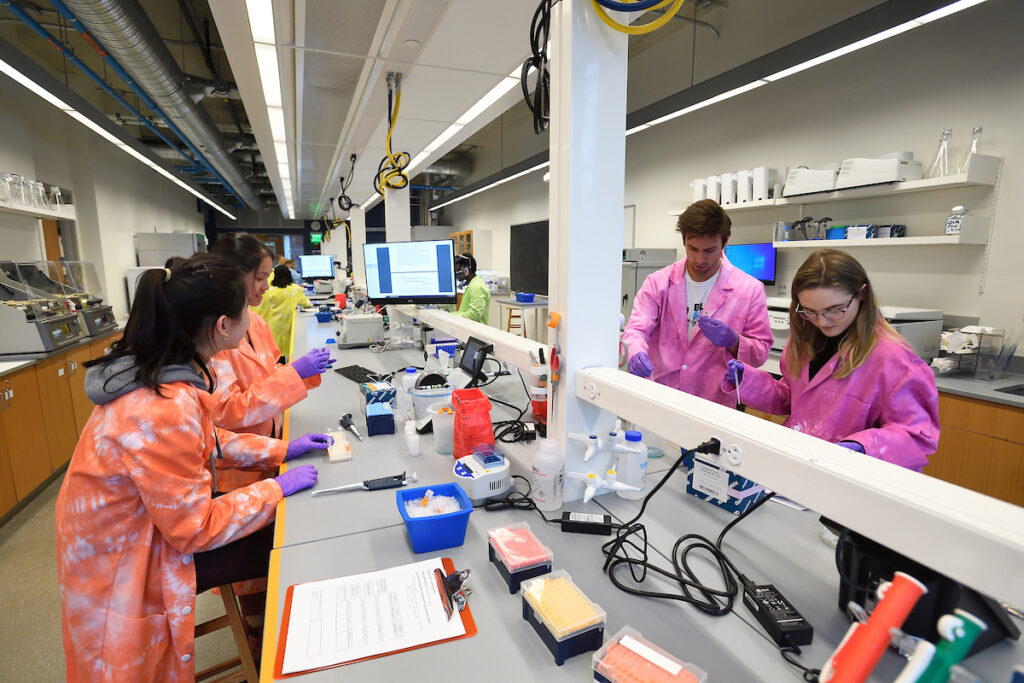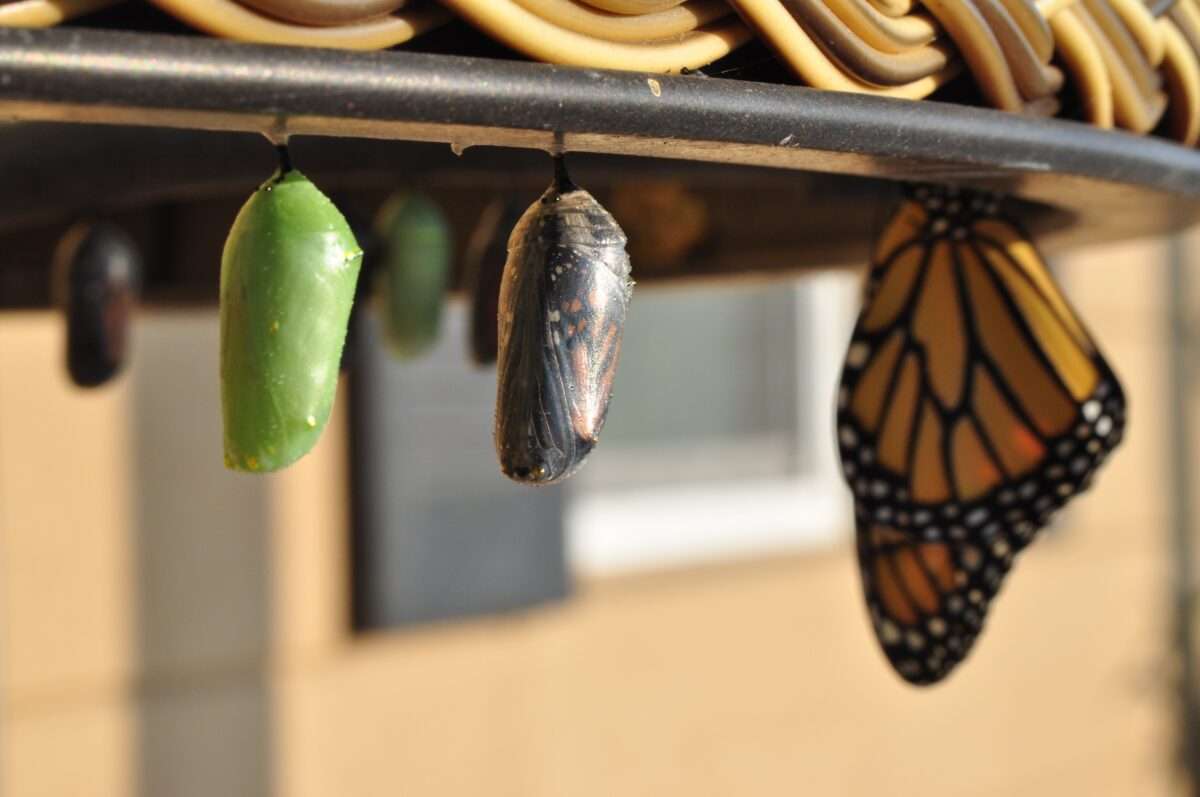- Search All Scholarships
- Exclusive Scholarships
- Easy Scholarships to Apply For
- No Essay Scholarships
- Scholarships for HS Juniors
- Scholarships for HS Seniors
- Scholarships for College Students
- Scholarships for Grad Students
- Scholarships for Women
- Scholarships for Black Students
- Scholarships
- Student Loans
- College Admissions
- Financial Aid
- Scholarship Winners
- Scholarship Providers

Student-centric advice and objective recommendations
Higher education has never been more confusing or expensive. Our goal is to help you navigate the very big decisions related to higher ed with objective information and expert advice. Each piece of content on the site is original, based on extensive research, and reviewed by multiple editors, including a subject matter expert. This ensures that all of our content is up-to-date, useful, accurate, and thorough.
Our reviews and recommendations are based on extensive research, testing, and feedback. We may receive commission from links on our website, but that doesn’t affect our editors’ opinions. Our marketing partners don’t review, approve or endorse our editorial content. It’s accurate to the best of our knowledge when posted. You can find a complete list of our partners here .
How to Write a College Transfer Essay (With Examples)

Lisa Freedland is a Scholarships360 writer with personal experience in psychological research and content writing. She has written content for an online fact-checking organization and has conducted research at the University of Southern California as well as the University of California, Irvine. Lisa graduated from the University of Southern California in Fall 2021 with a degree in Psychology.
Learn about our editorial policies

Bill Jack has over a decade of experience in college admissions and financial aid. Since 2008, he has worked at Colby College, Wesleyan University, University of Maine at Farmington, and Bates College.

According to the National Center for Education Statistics, over 1.2 million students are enrolled in college as a transfer student. Students may transfer for a variety of reasons ranging from academics to athletics to geography.
If you are in the process of transferring colleges it’s likely that you will have to write a personal essay as part of your transfer admissions process. Ultimately, there’s no one way to write a college transfer essay. Everyone is unique, and this individuality should shine through in your essays.
However, there are some recommended things to include, and even a real example essay that was used to successfully transfer college! In this post, we’ll help you write a powerful transfer essay so you can tell your story to the admissions committee.
Jump ahead to…
- Do’s and don’ts
- Why did you choose your current school?
What are your main reasons for transferring out of your current school?
Why do you want to attend the transfer school.
- Example essay
Additional resources
- Key takeaways
- Frequently asked questions
College transfer essays: The do’s and don’ts
Before we start, we want to cover a few basics do’s and don’ts about what your transfer essays should be about.
- Elaborate on how your current school has helped you progress towards your goals. Positivity is always a good thing!
- Research your prospective school (e.g. specific classes, organizations, opportunities) for why you want to go there.
- Make sure to follow the standard/correct essay format! Transfer essay prompts may vary from college to college so you should make sure that you’re answering the exact question.
- Use up your limited word count by listing negative aspects about your current school. Instead, focus on how it has helped you grow, but how another school could further help you develop your interests/passions
- List a group of random classes or opportunities available at your new school. Mention opportunities you’re (genuinely) interested in that relate to your goals and passions – make sure you’re telling a story through your essay.
- Copy your initial admissions essay (the one that you used when applying to colleges in high school) – you’ve changed a lot during your time in college so you will want to write a brand new essay.
Apply to these scholarships due soon

$10,000 “No Essay” Scholarship

$2,000 Sallie Mae Scholarship

Making the Leap Scholarship for Transfer Students

Niche $25,000 “No Essay” Scholarship

Martin Achievement Scholarship

$25k “Be Bold” No-Essay Scholarship

SENEDIA STEM Scholarship

Husband and Wife Law Team Scholarship

$10,000 CollegeXpress Scholarship
What is the goal of the transfer essay.
Potential transfer students should know that not all colleges and universities require transfer essays, so when in doubt definitely check-in with the college in question for clarification. For the purposes of this article and the sample transfer essay, we’ll be using this prompt:
Please provide a statement that addresses your reasons for transferring and the objectives you hope to achieve.
Most colleges will be interested in learning why you want to transfer and how transferring will help you achieve your goals. However, specific prompts will vary from college to college, so you should definitely pay attention to the specific prompt you are asked to respond to.
Some of the common questions you’ll come across include:
- How will your transfer school help you accomplish your goals?
Below I’ll break down how to respond to each of these questions and include an example from a successful transfer essay.
Also see: Can you transfer into an ivy league school?
Why did you choose your current school?
To answer this question, you’ll have to go back in time when you were in 12th grade and selecting your college. Did you choose the college because it had a program you liked? Maybe you really wanted to take classes with a specific professor? Maybe you thought you wanted to attend college in a specific part of the world? Whatever the reason you should lay it out in the most factual way possible.
Here’s how I responded to this question:
Just like Jeopardy, Criminal Minds is also a show that I have watched from a very young age, and one that I continue to watch quite regularly. Being exposed to this interesting world of FBI profilers for so long inspired me to want to dive into the world of psychology myself. Due to this, I originally chose the University of Wisconsin, Madison for its amazing psychology program, and because I wanted to try something new. Being from California, this “something new” came in the form of watching snow fall from the sky, seeing cheese curds being sold in all the grocery stores, and simply living somewhere far away from home.
Also see: How to write a 250 word essay
This is always an important question for transfer admissions officers: why did your current college not work out? We recommend that students be as honest as possible and stick to the facts (as opposed to simply complaining about your current school).
Students have very different reasons for changing schools, which often depend on what type of school you’re transferring from (a 2-year or 4-year). While many community college students transfer because their plans did work out and they’ve accomplished what they wanted to at their school, those transferring from four-year universities often do so for less positive reasons (which was my experience).
If the situation at your college didn’t exactly pan out as you thought it would, you should also try to talk about some of the ways you are making the most of the situation. This shows the admissions officers that despite the less-than-ideal circumstances, you have continued to learn, grow, and contribute to your community.
Here’s how I accomplished this:
Arriving in Wisconsin, I got exactly what I wanted: an amazing psychology program and the experience of being somewhere quite different from the place I called home. My classes were interesting, my professors were helpful and caring, and experiencing the first snow was quite exciting. However, as winter progressed, walking back from class everyday under the progressively gloomier sky seemed to be a cruel reminder that I was no longer in sunny Southern California. While eating dinner in our many dining halls, I always viewed the wide array of food available: quesadillas, Chinese food, burgers, even pecan pie. The food was all delicious, but going day after day without even seeing Korean food once made me miss those fun dinners with my family. Back at my dorm, my “home away from home”, it started to feel like anything but being at home. To feel more comfortable where I was, I decided to pursue things I liked, and that I was familiar with. My passion for psychology led me to join the university’s Psychology Club, where I was able to learn about recent revelations within the field of psychology, furthering my interest in the subject.
Going through the admissions process as a transfer student is interesting, because you have learned a lot about yourself and your preferences at your first college. This should provide you with a great perspective on what you are looking for next.
The two major things you’ll want to accomplish when answering this question are why the transfer college in question is a good fit for you and how it can help you accomplish your goals as a student.
Specificity is always more ideal here so you can show that you have spent some time thinking about what you want and also how the new college fits.
Here’s how I did this:
I plan on using the knowledge I gain in psychology, either from organizations or classes, to help people. I want to one day apply this knowledge to research, to discover possible methods to help the people suffering from the psychological problems I study. Alternatively, I hope to use this knowledge as a criminal profiler, using my understanding of psychology to narrow down pools of suspects. To be able to accomplish either of these, I need to develop a much deeper understanding of both people’s motivations for the things they do as well as of the many psychological issues people face. For these reasons, I am very excited at the prospect of exploring and enrolling in the classes offered by USC’s Department of Psychology. In particular, Psych 360: Abnormal Psychology would be an amazing introduction to psychological disorders and their causes. Psych 314L: Research Methods would then help me put this knowledge about disorders to good use by teaching me how to properly conduct research and find possible solutions for people’s problems.
College transfer essays: an example
Here we go! Throughout this article, I’ve shown you my college essay divided into sections, and now’s time for the full thing. I can honestly say that this essay had a 100% success rate! Without further ado, here is my full college transfer essay (and prompt):
Prompt: Please provide a statement that addresses your reasons for transferring and the objectives you hope to achieve.
I wake up from my daily after-school nap to realize that it is already dinner time. As I walk downstairs, I smell the delicious fragrance coming from my mom’s samgyetang (Korean ginseng chicken soup), one of my favorite meals. Soon enough, everyone sits down to watch the newest episode of Jeopardy , a tradition we’ve had going on for as long as I can remember. As I take that first sip of samgyetang, and miss yet another geography question on Jeopardy – and wait for my family to inevitably tease me about it – I feel at home, like I am somewhere that I belong. Wherever I go, I hope I can encounter that same warm feeling. Just like Jeopardy , Criminal Minds is also a show that I have watched from a very young age, and one that I continue to watch quite regularly. Being exposed to this interesting world of FBI profilers for so long inspired me to want to dive into the world of psychology myself. Due to this, I originally chose the University of Wisconsin, Madison for its amazing psychology program, and because I wanted to try something new. Being from California, this “something new” came in the form of watching snow fall from the sky, seeing cheese curds being sold in all the grocery stores, and simply living somewhere far away from home. Arriving in Wisconsin, I got exactly what I wanted: an amazing psychology program and the experience of being somewhere quite different from the place I called home. My classes were interesting, my professors were helpful and caring, and experiencing the first snow was quite exciting. However, as winter progressed, walking back from class everyday under the progressively gloomier sky seemed to be a cruel reminder that I was no longer in sunny Southern California. While eating dinner in our many dining halls, I always viewed the wide array of food available: quesadillas, Chinese food, burgers, even pecan pie. The food was all delicious, but going day after day without even seeing Korean food once, it made me miss those fun dinners with my family. Back at my dorm, my “home away from home,” it started to feel like anything but being at home. To feel more comfortable where I was, I decided to pursue things I liked, and that I was familiar with. My passion for psychology led me to join the university’s Psychology Club, where I was able to learn about recent revelations within the field of psychology, furthering my interest in the subject. I plan on using the knowledge I gain in psychology, either from organizations or classes, to help people. I want to one day apply this knowledge to research, to discover possible methods to help the people suffering from the psychological problems I study. Alternatively, I hope to use this knowledge as a criminal profiler, using my understanding of psychology to narrow down pools of suspects. To be able to accomplish either of these, I need to develop a much deeper understanding of both people’s motivations for the things they do as well as of the many psychological issues people face. For these reasons, I am very excited at the prospect of exploring and enrolling in the classes offered by USC’s Department of Psychology. In particular, Psych 360: Abnormal Psychology would be an amazing introduction to psychological disorders and their causes. Psych 314L: Research Methods would then help me put this knowledge about disorders to good use by teaching me how to properly conduct research and find possible solutions for people’s problems. With so many opportunities available at USC, I hope to not only help others feel more comfortable, but to find a second home for myself after all.
And that’s it! This essay touches on all of the tips listed above, and should serve as helpful inspiration as you begin your writing. Hopefully, it gives you an idea of how to integrate everything you should mention in a cohesive essay. With that, I wish you good luck with your college transfer essays (and applications)!
Don’t miss: What looks good on a college application?
If you finish your essay and still have questions about the transfer process, consider checking out these Scholarships360 resources:
- How to transfer colleges
- How to transfer from a community college
- Top scholarships for transfer students
- How to choose a college
- What’s the difference between a private and public university?
Key Takeaways
- Explain why you want to transfer, what you need that you are not getting at your current school, and why you chose your current school to begin with
- Always present things in a positive light
- Share how the transfer school will help you achieve your goals and why you are a good fit for the school
Frequently asked questions about writing college transfer essays
How are college transfer essays different from regular application essays, do all schools require transfer essays, can i reuse my old college essays for a transfer, what should you not say in a transfer essay, scholarships360 recommended.

10 Tips for Successful College Applications

Coalition vs. Common App: What is the difference?

College Application Deadlines 2023-2024: What You Need to Know
Trending now.

How to Convert Your GPA to a 4.0 Scale

PSAT to SAT Score Conversion: Predict Your Score

What Are Public Ivy League Schools?
3 reasons to join scholarships360.
- Automatic entry to our $10,000 No-Essay Scholarship
- Personalized matching to thousands of vetted scholarships
- Quick apply for scholarships exclusive to our platform
By the way...Scholarships360 is 100% free!
Read 2 Transfer Student Essays That Worked
Strong transfer essays can help pave the way to admissions offers.
Read 2 Transfer Essays That Worked

Getty Images
Though it isn't a golden ticket, a strong transfer essay may boost an applicant's odds of admission.
There are as many reasons to transfer colleges as there are transfer students. But regardless of why someone wants to move to a new institution, the process for doing so usually requires an admissions essay.
Colleges With the Most Transfer Students
Josh Moody Jan. 28, 2020

In a 2018 National Association for College Admission Counseling survey , 41.5% of colleges polled said a transfer applicant's essay or writing sample is of either considerable or moderate importance in the admission decision.
A compelling, well-written transfer essay doesn't guarantee acceptance – many other factors are at play, such as an applicant's GPA. However, a strong essay can be a factor that helps move the odds in the applicant's favor, says Kathy Phillips, associate dean of undergraduate admissions at Duke University in North Carolina.
Know What Colleges Are Looking For In a Transfer Essay
Some schools have prospective transfer students use the Common App or the Coalition Application to apply. In addition to the main essay, students may be required to submit a second writing sample or respond to short-answer questions, though this isn't always the case. Prospective students can check a college's website for specific guidance regarding how to apply.
Whatever application method they use, prospective students should be aware that writing a transfer essay is not the same as writing a first-year college application essay, experts advise. First-year essays are more open-ended, says Niki Barron, associate dean of admission at Hamilton College in New York. When applying as first-years, prospective students can generally write about any experience, relationship or goal that has shaped who they are as people, she says.
This contrasts with transfer essays, where the focus is typically narrower. Barron says she thinks of transfer essays as more of a statement of purpose. "We're really looking to see students' reasons for wanting to transfer," she says.
Katie Fretwell, the recently retired dean of admission and financial aid at Amherst College in Massachusetts, says prospective transfer students are in a position to be a bit more reflective about their educational goals because of their additional year or years of experience post-high school. The essay helps admissions officers get a sense of whether an applicant has done "an appropriate level of soul-searching about the match," she says.
Transfer Essay Examples
Below are two transfer essays that helped students get into Duke and Amherst, respectively. Both institutions are very selective in transfer admissions. For fall 2018, Duke had a transfer acceptance rate of 8% and Amherst accepted 4% of its transfer applicants, according to U.S. News data.
Hover over the circles to read what made these essays stand out to admissions experts.

Searching for a college? Get our complete rankings of Best Colleges.
Tags: education , colleges , college applications , students , transfer students , college admissions
2024 Best Colleges

Search for your perfect fit with the U.S. News rankings of colleges and universities.
College Admissions: Get a Step Ahead!
Sign up to receive the latest updates from U.S. News & World Report and our trusted partners and sponsors. By clicking submit, you are agreeing to our Terms and Conditions & Privacy Policy .
Ask an Alum: Making the Most Out of College
You May Also Like
How to decide if an mba is worth it.
Sarah Wood March 27, 2024

What to Wear to a Graduation
LaMont Jones, Jr. March 27, 2024

FAFSA Delays Alarm Families, Colleges
Sarah Wood March 25, 2024

Help Your Teen With the College Decision
Anayat Durrani March 25, 2024

Toward Semiconductor Gender Equity
Alexis McKittrick March 22, 2024

March Madness in the Classroom
Cole Claybourn March 21, 2024

20 Lower-Cost Online Private Colleges
Sarah Wood March 21, 2024

How to Choose a Microcredential
Sarah Wood March 20, 2024

Basic Components of an Online Course
Cole Claybourn March 19, 2024

Can You Double Minor in College?
Sarah Wood March 15, 2024

How to Write a Winning College Transfer Essay
December 27, 2021

Much like snowflakes, DNA profiles, or interpretations of a David Lynch film, no two college transfer applicants are alike. Even if two prospective transfers to Boston University are both named Fred and each hail from Farmington, CT, their paths, and the contours of their academic journeys are probably quite different from one another. Perhaps Fred #1 is a first-generation college student who, for financial reasons, had to complete his freshman year at the local community college. Perhaps Fred #2 underachieved a touch in high school, gained admission into a less-selective state school where he excelled freshman year and is now highly-motivated to study at top school. Each Fred possesses an equally valid story to tell the BU admissions office, and doing so adeptly may well be the key to their acceptance. After all, 42% of all U.S. colleges—and close to 100% of highly-selective schools—cite the essay as being “important” to their transfer application decisions.
To cite another relevant statistic, 37% of all college students transfer at some point in their academic career and each has a worthwhile pathway to chronicle. Whether you’re Fred #1, Fred #2, or someone not even named Fred (imagine that!), you need your transfer essay to be so strong that it leaps right off the page and captures the attention (or, even better, heart) of an admissions officer. In the following article, the College Transitions team will explain precisely how to master this essential component of the transfer application.
Which Transfer essay prompt should I pick?
Starting in 2020-21, the Common App granted its member institutions the option of allowing their transfer applicants to select one of the seven current Common App essay prompts (that are available to freshman applicants).
Some schools will offer you this option, while others will simply ask you the equivalent of “Why are you applying to our university?” If you are given the choice between prompts, it is generally best to select the one that is most broad (note: a broad prompt is good, a broad essay is not) and allows you to compose an essay containing the following essential elements:
- 1) Why your prospective transfer school is a perfect fit for you.
- 2) Why your journey has led you away from your current institution.
- 3) What unique attributes and talents you will bring to campus.
- 4) How your past achievements and efforts can bolster your case.
- 5) Share your academic and career ambitions.
Let’s dive in and take a more thorough look at each component, beginning with #1.
1) Why this college is the perfect fit for you
Share with your prospective new academic home exactly what makes them attractive to you. Smaller class size, a particular academic program, a more diverse environment, or the opportunity to for hands-on learning/research opportunities are just a sampling of the legitimate selling points you can cite. Mention specific courses that you are eager to take at their institution, certain distinguished professors who you desire to study under, and unique clubs, activities, or campus traditions in which you are excited to partake. Take advantage of this chance to impress admissions officers with you expansive knowledge of their institution as well as a highly-specific accounting of how you will take advantage of your 2-3 years there. Doing so will separate you from the pack of similarly-qualified transfer applicants.
2) Why you want to leave your current college
Make sure that the reasons that you communicate for wanting to transfer do not end up sounding like a nasty Yelp review of your present school. While you may want to leave College X because the professors are all centenarian windbags and your roommate is breeding capybaras to sell on Craigslist (is there really a market for that?), remember that the school to which you are applying wants to feel wanted. Think about it—would you rather listen to your girlfriend/boyfriend rant about their ex or hear them tell you what makes you awesome? Admissions officers considering a transfer student feel the same way.
3) What unique attributes you will bring to campus
Even in the transfer admissions process, admissions officers are tasked with enhancing the diversity of their undergraduate student body and adding individuals who are likely to be contributing members of the campus community. Is there a particular club that you are eager to join or do wish to start your own? Do you desire to assist a professor in conducting research? Are you an a cappella star or club volleyball diehard? What books do you read for pleasure? Do you have a hidden talent or area of expertise? Are you an introvert or extrovert (both can be selling points)? What ideas, activities, or dreams keep you up in the middle of the night? Give the admissions reader a full picture of what your life will look at their school and how you will make more of an impact (in any form) than many of your fellow applicants.
4) Talk about your academic and extracurricular record
This is also a perfect opportunity to demonstrate your record of involvement on your current campus. It is far easier to sell yourself as someone who will be a contributing member of the campus community if you displayed these qualities at your previous college. Students with an eye on transferring are sometimes so focused on escaping their first institution that they fail to become involved in anything outside of the classroom and thus miss out on valuable opportunities to demonstrate leadership and passion—the very traits needed to transfer to a prestigious school. Write about what you are most proud of—a challenging physics exam you mastered, a philosophy paper you wrote arguing the compatibility of science and religion, or how you started a campus chapter of an organization dedicated to fighting pancreatic cancer.
5) Share your academic and career ambitions
The more you can use your essay to communicate your genuine passions and what makes you tick, the better. Doing so gives your essay broader context and deeper meaning, as it explains the true significance of all of the info shared in steps #1-4. If you want to major in biology, where do you see that taking you down the road? Are you considering graduate or medical school? Do you want to work in research in a specific area? You don’t have to be 100% sure of your career and future academic path at 19 or 20 years old, but as a transfer student, you should share where your experiences and interests may someday take you.
College Transfer Essay – Do’s and Don’ts
- Make a coherent and well-researched case for why the school to which you are applying would be a perfect fit for you.
- Explain how you spend your time outside of school whether it’s participation in a club or sport, paid work, or a hobby to which you are extremely dedicated.
- Paint a picture of the reasons why this new university is the right place to pursue your academic interests.
- Give the committee a sense of your talents and character/personal qualities. If your school does not offer interviews, this essay will be primary vehicle through which you can forge a personal connection to a fellow human being.
- Bash your current school or overly-focus on the negative.
- Make excuses for past academic performance of lack of outside the classroom involvement.
- Say that you want to attend a new school for the prestige, the pretty campus, or for a personal reason (close to home, girl/boyfriend attends, etc.).
- Forget to do adequate research on your prospective academic home. Details matter!
- Application Strategies
- College Essay

Andrew Belasco
A licensed counselor and published researcher, Andrew's experience in the field of college admissions and transition spans two decades. He has previously served as a high school counselor, consultant and author for Kaplan Test Prep, and advisor to U.S. Congress, reporting on issues related to college admissions and financial aid.
- 2-Year Colleges
- Best Colleges by Major
- Best Colleges by State
- Big Picture
- Career & Personality Assessment
- College Search/Knowledge
- College Success
- Costs & Financial Aid
- Dental School Admissions
- Extracurricular Activities
- Graduate School Admissions
- High School Success
- High Schools
- Law School Admissions
- Medical School Admissions
- Navigating the Admissions Process
- Online Learning
- Private High School Spotlight
- Summer Program Spotlight
- Summer Programs
- Test Prep Provider Spotlight

“Innovative and invaluable…use this book as your college lifeline.”
— Lynn O'Shaughnessy
Nationally Recognized College Expert
College Planning in Your Inbox
Join our information-packed monthly newsletter.
I am a... Student Student Parent Counselor Educator Other First Name Last Name Email Address Zip Code Area of Interest Business Computer Science Engineering Fine/Performing Arts Humanities Mathematics STEM Pre-Med Psychology Social Studies/Sciences Submit
Transfer Essays That Worked

The essays are a place to show us who you are and who you’ll be in our community.
As a transfer applicant, your essay is a chance to tell the admissions committee more about your background or goals and how you would pursue them at Hopkins. Below you’ll find selected examples of transfer applicant essays that “worked,” as nominated by our admissions committee.
These selections represent just a few essays we found impressive and helpful during the past admissions cycle. We hope these examples inspire you as you prepare to compose your own essay. The most important thing to remember is to be original as you share your own story, thoughts, and ideas with us.
Read essays that worked from first-year applicants .
Essays that worked.

Bedtime Stories
Summer Mai Li connects the personal stories of her loved ones to global civil and human rights issues that she intends to study during her time at Hopkins.

Becoming a Better Mathematician
Jorge’s essay provides the admissions committee with a detailed narrative about his lifelong interest in mathematics: how he discovered it, cultivated it, and pursued it to the highest level available.

Pursuing My Passion in Research
Through her transfer essay, Klaire showcases her deep interest in advancing scientific research through her experiences at her community college and her future at Hopkins.

Application Workshops
Our interactive workshops—on topics like the college search process and essay preparation—will help you build your strongest application when you’re ready to apply.
REGISTER FOR AN APPLICATION WORKSHOP
Application tips in your inbox
Join our mailing list to receive insights from our admissions committee, event invites, and other resources for your college journey.
Quick Links:
- Majors, Minors & Programs
- Application Deadlines & Requirements
- College Planning Guide

How to Write a Great Transfer Essay
Here is the most common prompt for transfer students applying through the Common App :
“Please provide a statement that addresses your reasons for transferring and the objectives you hope to achieve.” (250-600 words)
The three key steps to mastering the transfer essay are as follows:
Step One: Establish why you want to transfer.
Tell admissions why you want to transfer, and do so without speaking negatively about your current institution. Are you looking for a bigger school? Do you want to attend a university in a tech-centric city? Did you just discover your passion for a major that your current institution doesn’t offer? Transferring is a big decision, so it’s important to show that your intentions are clear. Whatever the reason, refrain from speaking ill of your current school. You want to come off as optimistic and forward thinking to admissions.
Step Two: Demonstrate your interest.
Why are you applying to this school in particular? You’ve been through the admissions cycle before and you are wiser than you were a year or two ago. Admissions officers will expect that you’ve done your research and are making a calculated, thoughtful decision to transfer. Your interest in transferring to one school should be directly related to your reason for leaving your current school: What gaps or unmet needs will your prospective institution address? Do you want to transfer for the school’s humongous alumni network, award-winning journalism program, or non-profit affiliations? Have you always dreamed of living in the city in which the school is located? Make sure admissions knows that you aren’t applying because “it’s gotta be better than my current school” but because this school is where you feel you truly belong. Illustrate your drive and maybe you’ll be hitting the ground running come the fall. (Hint: the best way to get the information you need is by setting aside a chunk of time to pore over the school website. Sorry, there’s no shortcut, even the second time around.)
Step Three: Establish the highlights of your collegiate career so far.
You have an edge that most freshman don’t: You’ve already been to college, so you know a bit more about the experience as well as your own academic and career goals. Being able to say that you know you will succeed at your school of choice because you flourish in small classrooms, lead in group projects, excel in the math and sciences or whatever your reasoning may be is crucial. Talk about what you have enjoyed about college thus far (again, be positive!) and how you hope to build on your experience at your (hopefully) new school!
Once you complete these three steps, you will have all the ingredients for a fantastic transfer essay! But before you hit submit, a final word of warning: some schools require transfer applicants to submit supplemental essays (remember those?). Do yourself a favor and compile a list of these in advance to ensure that every essay you write reveals something new and special to admissions. But first, give yourself a pat on the back. By reading this post, you’ve already given yourself a leg up (at least we think so). Go you!
About Kat Stubing
View all posts by Kat Stubing »
We're here to help.
Written by Kat Stubing
Category: Admissions , advice , College Admissions , Essay Resources , Essay Tips , Essay Writing , Quick Tips , Tips
Tags: brainstorming , College , college admissions , college admissions essay , college applications , college essay , college essay advisors , college essay tutor , essay , essay advice , personal statement , transfer , transfer admissions , transfer application , transfer applications , transfer essay , transfer help , transfer student , transfer students , writing , writing advice , writing help

Want free stuff?
We thought so. Sign up for free instructional videos, guides, worksheets and more!

One-On-One Advising
Common App Essay Prompt Guide

Supplemental Essay Prompt Guide
- YouTube Tutorials
- Our Approach & Team
- Undergraduate Testimonials
- Postgraduate Testimonials
- Where Our Students Get In
- CEA Gives Back
- Undergraduate Admissions
- Graduate Admissions
- Private School Admissions
- International Student Admissions
- Common App Essay Guide
- Supplemental Essay Guides
- Coalition App Guide
- The CEA Podcast
- Admissions Stats
- Notification Trackers
- Deadline Databases
- College Essay Examples
- Academy and Worksheets
- Waitlist Guides
- Get Started
How to Write the Best College Transfer Essay
According to the National Center for Education Statistics, over 1.2 million students are enrolled in college as a transfer student. Students transfer schools for many reasons: It could be because they have completed an associate’s degree at a community college and want to pursue further education or because the university they initially chose didn’t meet their expectations.
Writing a successful college transfer essay can significantly increase your chances of being admitted to the transfer college of your choice.
In this article, we will help you write a winning college transfer essay that highlights your growth, showcases your unique experiences, and convinces the college admissions committee that you are the perfect fit for your new institution. If you wish to transfer colleges and want to learn how to navigate the transfer process, read on.
Understanding the Significance of Transfer Essays
What is a college transfer essay.
If you’re considering transferring schools, you’ll have to write a college transfer essay.
A transfer essay is a personal statement that addresses your reasons for transferring from your original college to a new college you want to attend. It provides an opportunity to explain why you are seeking a transfer and what objectives you hope to achieve at your future college.
The transfer essay plays a vital role in the admissions process. It gives admission officers a deeper understanding of your motivations, achievements, and potential contributions to their community. A winning transfer essay not only highlights your academic and personal achievements but also demonstrates your fit for the new school.
The Difference between Transfer Essays and Regular Application Essays
Writing a transfer essay is different from writing a first-year college application essay. As a transfer student, you already have academic experience to draw from. Instead of relying solely on general ideas and vague statements, use your genuine college experiences to illustrate how you will thrive in your new campus community.
Additionally, instead of writing one transfer essay that you’ll send to every college on your list, each transfer essay should be school-specific.
Your Mission Remains Unchanged
Even though you are applying to college as a transfer student, your main mission remains the same: creating a compelling and outstanding essay.
To achieve this, you should carefully select an intriguing and relevant story that highlights your growth and showcases why you are a perfect fit for the college you’re transferring to. Support your claims with detailed examples and articulate your unique qualities to make a lasting impression.
The Transfer Essay Prompt
The Common App granted colleges the option of allowing their transfer applicants to select one of the seven current essay prompts (that are also available to freshman applicants).
Before you start writing your transfer essay, it is essential to carefully read the prompts provided by the college or university you are applying to. The prompts will typically be a combination of questions that will ask you to explain:
- Why you chose your current school (don’t be too creative; the reason can be simply that you wanted to stay close to home)
- The ways you tried to make the best of your situation at your current school.
- How were your educational goals and expectations not met at your current institution (this could be a major or class your school did not offer)?
- Other reasons behind your decision to transfer.
Key Components of an Effective Transfer Essay
To ensure your transfer essay stands out from the competition, it is crucial to pay attention to these key components:
- Addressing the “Why” : One of the most important aspects of a transfer essay is explaining why you want to transfer to a new institution. Is it because of a specific program they offer? Or perhaps you’re seeking a better academic fit? Clearly articulate your reasons to transfer colleges and demonstrate your commitment to the institution you are applying to.
- Highlighting Personal Growth : Admissions officers are interested in understanding how you have grown since your initial college experience. Write an essay that reflects your experiences at your current institution, both inside and outside the classroom, and discuss how these experiences have shaped you. Mention specific examples of challenges you’ve overcome and how they have contributed to your personal and academic development.
- Demonstrating Academic Success : Your transfer essay is an opportunity to showcase your academic achievements and future goals. Highlight any notable accomplishments, such as excellent grades, research projects, or internships. Additionally, explain how the programs and opportunities at your desired transfer institution align with your academic and career aspirations.
To gain a better understanding of what a strong transfer essay looks like, it’s helpful to examine examples. Look for essays from successful transfer students who were accepted into their desired institutions. Analyze their writing style, structure, and the way they effectively convey their motivations and aspirations.
The Common App and Transfer Applications
Navigating the transfer application process can be complex, especially when using platforms like the CommonApp. Here are some tips to help you tackle the application process efficiently:
- Researching and Shortlisting : Take the time to research different colleges and universities that you are considering for your transfer. Pay attention to their transfer requirements, academic programs, and campus culture to ensure a good fit. Create a shortlist of institutions that align with your goals and priorities.
- Addressing Challenges and Misconceptions : Many students face challenges and misconceptions when completing their transfer applications. Common concerns include credit transfers, financial aid, and deadlines. Seek guidance from your academic advisor or the transfer admissions office to clarify any doubts and ensure a smooth application process.
Although most colleges will use the Common App, some (MIT, Columbia, Canadian Universities…) use the Coalition App (Scoir) or their own application portals.
Dos and Don’ts of Writing a College Transfer Essay
When crafting a transfer essay, it is crucial to approach it with careful consideration and strategic planning. To ensure that your essay stands out from the competition and effectively communicates your unique qualities, take note of the following guidelines:
- Highlight the positive impact of your current school: Emphasize how your current institution has contributed to your personal growth and academic progress. It is essential to convey gratitude while showcasing how another college can further enhance your interests and aspirations.
- Exhibit thorough research: Demonstrate your familiarity with the prospective college by illustrating your knowledge of their programs, professors, values, and opportunities. This will impress admissions officers and reinforce why the institution aligns perfectly with your educational and personal goals.
- Adhere to the correct essay format: Each college might present different transfer essay prompts. Therefore, carefully read and analyze the question to ensure that you provide a precise response while maintaining the appropriate essay structure.
- Dwell on negative aspects: Avoid using valuable word count to list negative aspects of your current institution. Instead, focus on how your current school has helped you grow, while explaining how the school you’re hoping to transfer would allow you to further develop your passions and interests.
- Include irrelevant or inappropriate personal details: Stay focused on relevant experiences and personal growth that are directly related to your intended goal. Refrain from oversharing personal information that may detract from your main argument.
- Provide unnecessary information or digress: Admissions officers appreciate concise and well-structured essays that effectively communicate your motivations and objectives for transferring. Avoid tangents and unnecessary details that could potentially dilute the impact of your essay.
- List random classes or opportunities at the new school: Instead of merely listing opportunities, emphasize your genuine interest in specific programs or opportunities that directly relate to your goals and passions. Remember to weave a compelling narrative throughout your essay.
- Reuse your previous admissions essay: Since you have undoubtedly undergone significant personal and academic growth during your time in college, it is crucial to write a fresh essay specifically tailored to your application.
How to Write a Successful College Transfer Essay
Explain your reasons for transferring from your current college.
One of the key components of a successful transfer essay is clearly articulating your reasons for wanting to leave your current college. When discussing your reasons, consider both academic and personal factors. Are there specific academic programs or extracurricular activities at the new school that align with your interests and goals?
Did your current college lack opportunities for growth and development? Reflect on these questions and provide specific examples to support why you decided to transfer and why you will make a great addition to their student body.
Highlight Your Academic and Career Aspirations
In addition to explaining your reasons for transferring, it is crucial to outline what objectives you hope to achieve at your future college. Are there specific majors, research opportunities, or internship programs that align with your career aspirations? Discuss how the new college’s resources and environment can contribute to your personal and academic growth. Remember to be specific and demonstrate your knowledge of the specific institution.
Avoid Trash Talking your Current School
Students may be baited into talking negatively about why they want to transfer from their schools. Honesty is good, but you need to avoid trashing your school and rather focus on presenting a positive image of yourself and showing how you can thrive in a new environment. Colleges don’t want to admit someone else’s problem student.
If all you do is talk about how horrible your current situation is, you won’t really convince them that you are the type of person who has a lot to offer and a brilliant trajectory in front of them. Stay positive and talk about how the new university fits you better, how you will fit there, and what you have to offer.
Showcase Your Growth
You’re older, smarter, and better than the guy or girl who wrote that first-year application essay. You’ve grown and learned and have so many more relevant stories and thoughts to share. Write a personal essay to show them the current you, not who you were two or more years ago. It’s usually pretty transparent when students do this and it rarely works as planned.

Seek Inspiration from First-Year Admission Articles
To navigate your transfer app journey effectively, consider exploring articles related to first-year admissions as well. Although the application process may differ, these resources can provide valuable insights and guidance in crafting your transfer essay. By learning from the best practices utilized in first-year admissions, you can better position yourself as a strong candidate for admission.
See more in our Essays category
Frequently Asked Questions About Writing College Transfer Essays
What is a college transfer essay, and why is it important.
A college transfer essay is a written statement that explains why a student wants to transfer from their current college to another. It is crucial because it offers applicants an opportunity to showcase their reasons, aspirations, and how the new college aligns with their academic and career goals.
What should I include in my transfer essay?
Your transfer essay should include reasons for transferring, educational and professional goals, and a genuine interest in the prospective college. Reflect on the experience at your current school and discuss challenges you’ve faced, lessons learned, and how the new institution can fulfill your aspirations.
Can I use the same transfer essay for multiple colleges?
While you can reuse certain elements, it’s crucial to tailor each essay to the specific college. Mention unique aspects of the prospective college that appeal to you and explain how it aligns with your goals.
How long should my transfer essay be?
Follow the guidelines provided by the prospective college. Typically, transfer essays range from 500 to 1,000 words. Be concise, focusing on impactful storytelling and key points.
Should I mention academic setbacks in my transfer essay?
Yes, but frame them positively. Discuss challenges you’ve faced and emphasize how you’ve grown and learned from them. Highlight your resilience and determination.
Can I reuse my old college essays for a transfer?
Reusing your old college essays verbatim for transfer applications is not recommended. Instead of copying them directly, you can use them as inspiration and a solid foundation. Remember to update and adapt these essays based on your new experiences and circumstances. Additionally, your writing skills may have improved since your initial applications, so take advantage of that and improve your essays.
In conclusion, writing an outstanding transfer essay requires careful consideration and thoughtful storytelling. As you navigate the transfer admissions process, we hope this guide helped you learn how to write a strong college transfer essay. Craft a compelling narrative by emphasizing your growth, focusing on the positive, and showcasing your unique experiences.
The admission landscape is super competitive (especially if you’re an international student), and college students transfer for various reasons. By following these tips, you’ll write a fantastic transfer essay that can increase your chances of successfully transferring to your dream college or university.
Related Posts

Best Brainstorming Questions For Your Personal College Essays

How to Write the Best Personal Essay for College Applications

How to Write an Outstanding Scholarship Essay
Trending now.

How to Write a College Transfer Essay: A Step-by-Step Guide

Reviewed by:
Rohan Jotwani
Former Admissions Committee Member, Columbia University
Reviewed: 10/05/23
If you’re considering switching colleges and want to learn how to write a college transfer essay, read on.

There are multiple reasons to transfer colleges: you weren’t able to get into your top choice in your first round of applications, you want to change your major , or maybe you just have the world’s worst roommate.
Whatever your reason may be, you should know the transfer process can be lengthy and will differ from your original college applications. For instance, now that you’ve completed some postsecondary education, your undergrad grades will be considered more than your high school GPA.
Additionally, you’ll have to write a college transfer essay to introduce yourself to the committee and explain why you’d like to join their school. This essay tends to be the hardest part of transfer applications.
If you’re unsure of where to begin or how to write a successful college transfer essay, this guide has got you covered!
How to Write a College Transfer Essay
Here is a breakdown of how to write an impressive college transfer essay.:
How to Start the Transfer Essay
Your introduction is arguably the most important part of your essay because it’s the first paragraph the committee will read. Accordingly, it has to be intriguing enough to urge them to continue reading.
Many students start their essays with a statement or story related to their reason for transferring. A safe way to begin your essay is to share a specific principle you have about education that is rooted in an authentic experience.
Maybe you’ve always valued hands-on learning and have a famous story about taking apart your dad’s favorite replica aircraft and putting it back together to learn how it works.
Or, maybe you had a sick relative whose experience in and out of the hospital made you appreciate scientific experimentation and discovery, leading you to pursue medicine at a research-intensive school.
Regardless of your educational principles, ensure you use a memorable experience to share it. Immerse the readers into your narrative so they feel more connected to you and your words! Here are some tips to keep in mind when writing your introduction:
Reconsider Using Famous Quotes
While there have been successful college transfer essays that used quotes as their opening line, you should avoid overused quotes. If you’re beginning your essay with the phrase “knowledge is power,” it’s time to revisit your list of motivational quotes.
If you’re set on opening your essay with a quote, choose one the committee hasn’t heard before and think outside the box! You could choose a quote from your favorite book, a show, or a movie. An even better way to ensure you use a unique opening is to quote a family member or friend!
Maybe your mother always told you to stand up for yourself and that “if someone hits you, you hit them right back!” This seemingly unrelated quote could be used to explain how you’ve always been your biggest self-advocate and fight hard to have what you want, including a high-quality education.
Forget the Theatrics
You don’t have to choose a story with a nail-biting hook or dramatic ending. Your story doesn’t need to involve a near-death epitome, a tragic loss, or a heroic save. Keep it simple!
By that same token, don’t use exaggerated or false stories just to prove a point. The admissions committee will see through this and will dock you points for being ingenuine.
Explain Why You Chose Your Current School
Once you’ve written an attention-grabbing introduction, the next step is to explain why you chose your current school. Perhaps the school boasted its Socratic teaching method that allows students to take charge of their education. Or, it offered a program of specific interest to you. Maybe you chose it simply because it’s one of the top colleges to transfer to .
Regardless of your reasons, you must include them in your essay to explain how your expectations were not met. This part should be fact-focused. Be succinct and list the reasons you chose your current school over others.
Explain the Reasons You Want to Transfer
Once you’ve recounted the reasons you chose your current school, think about the reasons you decided to leave it. A large part of learning the art of essay writing is knowing what not to say! While you want to remain honest, your answer should revolve around the education you received at your school.
Here are some questions to ask yourself as you write this part of your essay:
- Did your program/institution live up to all of your expectations?
- Did you receive the education and support you hoped for?
- Were there enough opportunities for intellectual, personal, and professional growth?
- Are you closer to achieving your career goals after attending your current school?
- What’s missing from your education? What makes you hesitant to stay at your current school?
- Have your career plans changed? Can your current school offer you the resources you need to pursue this new path?
Even if you’re transferring because your roommate never washes the dishes or you’re trying to escape a clingy ex, the admissions committee won’t be interested or amused by these reasons.
Focus on the positives of your school but explain how they fell short. Perhaps the Socratic teaching method you hoped for fell short of equal dialogue and was more of a typical lecture. Maybe you had a eureka moment in an elective that made you want to switch to a program your current school doesn’t offer.
On the other hand, your current school may have already fulfilled the role it was meant to play. For instance, you may have chosen your current school to stay close to home and care for a sick family member or to take general courses to boost your GPA.
Explain how these goals were fulfilled and how you’d like to move on to the next stage of your education. No matter what your reasons for transferring are, you’ll need to provide concrete examples to support your claims. Share specific experiences that led to your decision to transfer schools.
This part of your college transfer essay can be tricky. You’ll want to provide concrete examples of how your current school fails to meet your expectations without badmouthing it. To find this balance, avoid making these mistakes:
Placing Blame
Don’t blame your current school for failing to meet your expectations.
Explaining how the professors were monotonous robots with no enthusiasm for teaching or that the class sizes were far too big to feel connected to your mentors will make you seem too critical.
You want to phrase your issues in a way that still sheds a positive light on their curriculum and community. In essence, you want to follow a “it’s not you, it’s me” type of explanation! You should explain how your current university offers great resources but not the best ones for your personal aspirations.
Throwing In the Towel
You should also mention the ways you tried to make the best of your situation at your current school. Even though you ultimately realized your school couldn’t offer you the education or resources you need, you should demonstrate your determination to make it work.
If your main issue was the lack of connection between you and your professors, you could share how you attended office hours regularly to have more one-on-one conversations. Demonstrate you tried to remedy your issues before deciding to transfer. This will show maturity, perseverance, and adaptability!
Explain Your Academic and Career Goals
This next part of your essay should be tied to what you’ve said previously. Think about your academic goals and what your plans are for the future.
Here are some questions to guide this part of your essay:
- Where do you hope your education takes you?
- What will your education be used for?
- What grades do you hope to receive?
- What program will help you achieve your career goals?
- What kind of mentors do you believe will help you achieve your academic and career goals?
- What school-based extracurriculars will aid you in your aspirations?
Use these questions to figure out what your specific academic and career goals are.
Explain Why You Want to Attend the Transfer College
Using the ideas you brainstormed from the previous sections, you want to focus your attention on explaining how your academic and career goals will be best met through your transfer college.
Research your transfer college well and provide specific reasons explaining why you want to attend. Go deeper than simply retelling the school’s main values, and explain why you’re choosing it in detail.
Focus on the type of education it provides, the school community and environment, and unique educational offerings, such as a particular program, teaching method, or experiential learning opportunities.
This part of your essay should be tailored specifically to your transfer college. If you can plug in any college name and use the same essay, you’ll need to add more details and continue working on it.
Take Responsibility for Any Hiccups
Another factor to consider is taking responsibility for any shortcomings. If you’re transferring colleges and have low grades or otherwise unfavorable aspects on your application, you should hold yourself accountable in your essay.
Do not blame your current school for your low grades. Even if you had a poor experience that made it difficult to excel, your grades are ultimately your responsibility. Explain how you will improve in your transfer school and the steps you’ve taken to become a stronger student.
Focus on Reflection
Your college transfer essay is essentially a reflection on your university experience and goals. This helps narrow things down and ensure you don’t choose a taboo essay topic . Just keep it simple and truthful by sharing your academic journey and why it’s brought you to where you are today.
As important as it is to share your next steps and eagerness to join your transfer school, it’s equally as important to reflect on the present and past.
You should reflect on your own educational principles, your reasons for attending your current school, the ups and downs that influenced you to transfer, and finally, how your transfer school will assist you in the next stage of your educational journey.
Keep It Casual
Your transfer statement isn’t your typical structured, formal three-body paragraph essay. Keep it casual, and don’t be afraid to use contractions or more colloquial language.
While you, of course, want to avoid using slang or distasteful language, you should let your personality shine through and give your essay a more conversational feel.
The admissions committee should feel like they’re getting to know more about your essence and values, not just your impeccable writing skills—although those are essential to demonstrate too!
Have Clear Intentions
Admissions committees will appreciate if you can demonstrate clear direction and intention in your essay. Provide specific examples of what you need your university to provide to help you reach your goals and how these needs are not being met currently.
Demonstrate Your Growth
Your university experience should offer you more insight and perspective on education. Share this perspective in your essay and prove you are a mature and insightful student.
A good indicator of maturity is speaking positively about your current school despite its limitations. You should portray both an eagerness to pursue other options and an appreciation for your current university. In other words, you should prove that while your current school isn’t the best fit for you, it’s still an excellent school!
Make it Personal
We’ve said it multiple times, and we’re saying it one last time in hopes you won’t forget. Use as many concrete examples as you can throughout your essay. Do not rely on any vague aspirations or reasons for transferring.
Go deeper than simply wanting a higher quality education! What made your current school’s education unsatisfactory? What experiences led to the conclusion that you needed more? How can your transfer school fill in this gap?
Keep in mind that this advice also applies to a transfer applicant’s personal statement. The overall goal is to be as genuine as possible while staying true to your goal - communicating your desire to attend the college.
Edit Multiple Times
You may have great ideas and an excellent story to tell in your essay, but having poor grammar or spelling errors will reduce your essay’s effectiveness.
Ensure you edit your essay multiple times before submitting it. Take time between your editing sessions so you can look at it with fresh eyes each time. You’re more likely to catch errors this way!
How to Conclude the Transfer Essay
Overlooking the conclusion of your essay can make what would be an amazing essay a good essay. Considering schools are highly selective with transfer applications , especially Ivy League schools , a good essay is unlikely to win you any points with the admissions committee.
Imagine your essay as a circle. To complete the circle, your final paragraph should reiterate the themes and principles mentioned in your introduction. Revisit the story you shared and reflect on the educational principle that guided your essay.
Briefly reiterate what type of education you could receive at your current school—a great but ultimately unsuitable one—and mention the better-suited education you’d receive at your transfer school.
The final conclusion in an essay for transfer students should be short, sweet, and straightforward. It should not:
Leave the Readers Wanting More
There should be no cliffhangers in your essay. You aren’t writing a novel with a sequel; this essay is all the admissions committee will receive, so you want it to paint a comprehensive and complete picture of yourself.
Introduce New Information
Don’t use your conclusion to throw in any afterthoughts you had while revising your essay. You’ll have a lot of ideas for what to include in your essay, but you shouldn’t try to fit all of them into such a limited space.
Make Promises
Don’t try to convince the admissions committee to accept you into their programs by making bogus promises. You don’t need to promise them you’ll be a stellar student at the top of your classes or that you’ll make great contributions to their school community.
There should be no ultimatums in your essay! If you find yourself writing a sentence along the lines of “If you accept me into your school, I promise to…”, dial it back and refocus your conclusion.
Mistakes to Avoid in Your College Transfer Essay
When crafting your college transfer essay, it's essential to steer clear of common pitfalls that can hinder your chances of acceptance. This is especially important in writing effective transfer essays for Ivy League schools that are looking for the best of the best.
Clarity Is Key
Make sure your essay is crystal clear in explaining your reasons for transferring and what you hope to achieve at your prospective new college. Avoid vague or overly broad statements that might leave the admissions committee perplexed about your motivations.
Emphasize Positivity
Another crucial mistake to avoid is adopting a negative tone throughout your essay. While acknowledging your reasons for transferring is important, dwelling solely on the negative aspects of your current college experience can be off-putting. Instead, emphasize your desire for fresh opportunities and personal growth.
Tailor Your Essay
One-size-fits-all essays are also to be avoided. When you look at an
sample of a transfer statement or an essay that’s been successful, you’ll notice that it’s not generic. So, do your best to tailor your essay to the specific college you're applying to, highlighting what makes that institution the right fit for your educational goals.
Focus on Aspirations
Additionally, resist the urge to place blame on your current college, professors, or classmates for your decision to transfer. Focus on your aspirations and what you hope to achieve at the new college.
Stay Realistic
Be realistic in your expectations; avoid making it sound like the new college is a magical solution to all your academic or personal challenges. Keep your essay concise and within the prescribed word limit, as admissions officers have many essays to review.
Thorough Research Matters
Thoroughly research the new college and mention specific programs, professors, or resources that align with your goals. Grammatical errors and spelling mistakes can detract from your essay's impact, so proofread it carefully.
Highlight Personal Growth
Lastly, don't forget to showcase personal growth and the lessons you've learned from your current college experience. Admissions officers appreciate applicants who demonstrate self-awareness and a commitment to growth.
Hopefully this breakdown has inspired you to write your own memorable essay.

College Transfer Essay Example
Understanding the steps to write a college transfer essay and what to avoid is a great place to start, but you might still be struggling to visualize what an excellent transfer essay looks like. Take a look at these examples of transfer essays to get started.
Essay Example #1
Here is a successful college transfer essay example that got a student into Duke University—a school with a transfer acceptance rate ranging from 3% to 7% in the past five years.
“A goal without a plan is just a wish, and I don't consider myself to be a wishful thinker, but a person of practical approach. And so, when I began my freshman year of college, Louisiana State University was strategically the best available option.
LSU offered the scholarships I needed, including the statewide TOPS program which, at the time, guaranteed the price of tuition for anyone with an ACT score of twenty-seven or above.
Additionally, LSU had no cap on early credit, which allowed me to put to use the seventy-four hours I had amassed in high school towards pursuing majors in political science, economics, and French with an Arabic minor.
However, I didn't know the hindrances I would face at LSU in pursuit of my chosen career path until I was plugging into the campus community, at which point I found a number of pragmatic reasons that LSU is no longer appropriate for the goals towards which I am working.
The obstacles began to arise when I finally honed my interests. I distinctly remember change brewing as I sat in my biweekly social contract seminar listening to my professor discuss the paper he was working on, in which he aimed to tie human prosociality to neuroplasticity, all of which, he argued, would undermine Hobbes’ social contract theory.
That’s what I wanted – not the subject matter, but the principle. I wanted the attempt; I wanted to learn and to theorize and even to be wrong sometimes. I wanted to translate my interdisciplinary interests in political and economic theory into applicable policy.
Given my passion for writing and discussion, sharing theories and findings with colleagues and inspiring students, too, was ideal. And so, I finally knew I wanted to be a professor of public policy.
Sadly, LSU did not have a public policy program, and so I defaulted to political science. However, the political science department is inherently theory-based rather than policy-oriented. From studying the public policy curricula of other universities, I know that a public policy program is more suited to my own interest in applications of governance.
Undeterred by this initial setback and eager to begin my journey in the world of academia, I immediately sought research opportunities, but I quickly learned that they weren’t easily accessible.
Upon meeting with counsellors, I was told I would have to find professors to work with on my own, as there was no designated undergraduate research database or protocol.
This in itself was another stark concern as I need a university in which conducting research is an integral part of the collegiate experience as it is a necessity in my education and preparation for the future.
Though I have contacted professors, happy to take any experience I can get, I have found that most positions are reserved for upperclassmen and are primarily data entry oriented.
Also, the lack of a public policy program has meant that the available work I have found does not meet the particular needs of the future policy-oriented research in which I hope to engage.
Though I know I could do well at LSU and receive an amazing education, staying at the university would mean, at best, having to overcome serious curricular deficits in achieving my goals or, at worst, having to change my plans altogether.
And so, I have resolved to transfer in an effort to give myself the best possible opportunity to prepare for and succeed in my future.”
Why This Essay Works
Like the Duke admissions committee, you were likely impressed by this essay! To ensure you know exactly what to include in your own essay, here are the aspects that make this Duke-approved essay successful:
Its Interesting Opening
This student uses their own quote to open their essay. As simple as their introduction is, it gets the point across and intrigues the reader to learn more.
Right off the bat it also proves this student has a sense of direction; they have plans that they are determined to fulfill. This not only shows ambition but proves to the admission committee this student has actually put thought into their choice to transfer.
Its Use of Concrete Examples
The student recounts the exact moment they realized their current school did not offer the resources they needed to succeed. This personal story makes the essay more authentic and immerses the readers into their life and thought process.
Its Positive Outlook
While the student lists all the reasons for their transfer, namely that their current school does not offer the right program and that it has limited research opportunities, they remain positive throughout.
They still praise their current school for its excellent scholarship program, early credit approval, and thought-provoking lectures, but contend they require more to reach their goals.
This student also demonstrates their willingness to persevere and make the best of their situation by searching for research opportunities and joining the next best program available. Yet, despite their efforts, they decided a transfer was in their best interests. These traits, perseverance and self-awareness, are key to a great transfer essay!
Its Effective Conclusion
This essay proves your conclusion doesn’t have to be elaborate to work. This student’s conclusion reiterates their opinions on their current school, that it is great but not perfect, and states their opinions on their transfer school, that it can offer them the most opportunity. It is simple yet highly effective!
Essay Example #2
Take a look at this second transfer essay example . It was provided by Miami Dade College, which also has a collection of successful examples of personal statements for transfer applicants to refer to.
Though the school this particular essay example was written for is unknown, it was indeed a successful essay and has much to offer.
“On a dark and breezy night after a hurricane sped through town, a tall little girl sat on her great-aunt’s porch in Santa Clara and stared at the stars she had never before seen. They’re so bright, she thought in awe.
They seemed so near, she might be able to reach out to the ashy vastness and grab one, maybe put it under her pillow to brighten her dreams. With eyes wide open, she listened to her momma tell stories of men with belts, and twin sisters, and brother bears, such fantastical worlds that made more sense than her own.
A crooked smile adorned her chubby face as she sat on her momma’s lap amidst the laziness of a late summer weeknight. Her warm, mud pie eyes seemed to be too big for her little face every time they opened with wonder or grew with curiosity. The light that would shine from within them was something to behold.
The way she would perk up at the mention of an adventure or a possible journey was almost comical. She was such an expressive child it felt almost as if you were watching a miniaturized adult. Sometimes, she would place her awkwardly big hands on her little hips and furrow her dark eyebrows as she reprimanded her dog for chewing apart her favorite Reptar quilt.
A brave little thing she was, that charcoal-haired girl. She walked across the river before the others, making up a little trail on the rocks as she went so they weren’t scared. She challenged the fastest runner in third grade to a race; even though she lost, all the girls in fifth grade suddenly wanted to become her best friend.
She wasn’t popular, but people knew her as the one who they could talk to. She wasn’t wise or all-knowing, but she always had something to say. She was an odd child, if not strange.
She was quite tranquil, she never really cried when she fell from her bicycle. Instead of playing house, she played librarian. Instead of drawing pink flowers and blue skies, she would write her momma letters.
Defining her was as difficult of a task as separating the different flavors of a melted Napolitano ice cream on a sticky Sunday afternoon. Yes, she was simple, but she had these moments where she would take the ordinary out of the world and make you forget there was something rather bland about everyday life.
As that little girl grew older, she reminded herself of who she was, and promised never to forget. She vowed to remember how she grew up and reaffirm her belief in herself. She grew quickly, almost skipping through the teenage years like a child would through a hopscotch game.
It happened so fast, it was almost impossible to distinguish at one point she was a little girl with a big dream, and when she turned into a woman with great hopes for her future.”
It’s clear why this essay was a success. Keep reading to learn why it resonated with the admissions committee.
Compelling Storytelling
This essay begins with a captivating story set against the backdrop of a hurricane. It describes a young girl sitting on her great-aunt's porch, gazing at the stars with awe. This vivid imagery immediately draws the reader into the narrative, making it easy to picture the scene and the girl's sense of wonder.
Emotional Connection
As the story unfolds, the reader is not just told about the girl's experiences but is made to feel them. We witness her curiosity, her bold challenges (like racing the fastest runner in her class), and her unique quirks (such as playing librarian and writing letters instead of drawing). This emotional connection helps us relate to the girl and understand her character.
Smooth Transition and Reflection
The essay smoothly transitions from describing the girl's childhood to her growth into a young woman. It skillfully highlights her commitment to maintaining her sense of self and personal growth. This transition bridges her past experiences with her future aspirations, making her transfer to a new college a natural and logical step in her journey.
Symbolism and Metaphor
The use of symbolism and metaphor enhances the essay's impact. The comparison of the girl's personality to "melted Napolitano ice cream on a sticky Sunday afternoon" vividly conveys her complexity. It suggests that she can transform ordinary situations into something extraordinary, hinting at her potential contributions to a new academic environment.
Resonance and Promise
The essay closes on a reflective note, emphasizing the girl's promise to remember her roots and her rapid transformation into adulthood.
This conclusion creates a sense of resonance with the reader, leaving a lasting impression of her character and determination. It implies that she is ready for the opportunities and challenges that lie ahead in her college journey.
Hopefully, these samples of transfer essays have inspired you. To learn more, check out these other transfer essay examples .
FAQs: Writing a College Transfer Essay
We’ve provided an in-depth tutorial on writing a college transfer essay that’ll impress the admissions committee and get you into your dream school. For any remaining questions, read on to find your answers.
1. How Do You Start a College Transfer Essay?
The best way to start a college transfer essay is by sharing a memorable experience that either influenced your decision to change schools or is integral to your perspective on education.
2. How Long Should My Transfer Essay Be?
The exact length of your transfer essay will depend on the university you are applying to. However, these essays are typically around one to two pages long.
3. How Do You Write a Short Transfer Essay?
Some universities will ask that your transfer essays do not exceed one page or around 250 words. In this case, it’s essential you still include all the necessary information listed in this guide but do so in a succinct way. Here are some general tips to make sure your short transfer essay still packs a punch:
- During the brainstorming process, separate all the great ideas from the excellent ones; only use the excellent ideas
- Share only one concrete experience that influenced you to transfer colleges
- Keep your introduction and conclusion short, preferably only a few sentences each
- Use simple, straightforward language and avoid overly flowery language that takes up valuable space
- Focus on the big reasons you want to attend your transfer college, leave smaller perks out
While it may seem counterproductive, you should write your first rough draft without paying attention to the word count. If you worry too much about staying within the limits, you may leave out important ideas or overthink your narrative.
Once you’ve written out a good rough draft, spend time revising and cutting down to meet the requirements. This way, you’ll have all of your ideas written out and can pick the best ones.
4. What Should You Not Write in a Transfer Essay?
You should avoid the following in your college transfer essay:
- Overused or generic quotes
- Badmouthing your current school
- Blaming your current school for its inability to meet your expectations
- Exaggerated stories
- Vague reasons for your transfer
- Generic reasons to join your transfer school
- A conclusion that leaves the readers with more questions
You should avoid making any grammatical, syntax, or spelling errors in your essay, as doing so will make it less effective. Also, keep in mind that using the same college essay for your transfer application is not a good idea. It may make you appear insincere and not fully engaged in your new academic path.
5. How Important Are Transfer Essays?
Your transfer essay isn’t the only application material the admissions committee will consider. However, it can play a large role in their selection process. In a recent survey, it was found that almost half of all participating colleges stated the transfer essay has considerable or moderate importance.
Hence, it’s essential you spend an adequate amount of time perfecting your essay to ensure it helps rather than harms your chances of acceptance.
6. How Do You End a College Transfer Essay?
You should end your college transfer essay by revisiting the principle, experience, or statement you used in your introduction. Reiterate this sentiment and expand on it after sharing your experience with your current university and the experience you hope to have at your desired school.
Keep your conclusion brief and avoid making any promises to the admissions committee or including new information that would require further explanation.
7. Are College Transfer Essays the Same as Personal Statements?
No, you’ll write personal statements during your first round of applications. These statements are more open-ended and broad than college transfer essays. They simply give the admissions committee more insight into who you are.
Students may choose to write more about their academics, extracurriculars, or life experiences that influenced them to pursue a certain career path. The main purpose of your transfer essay is to explain why you’re switching schools.
Final Thoughts
Don’t underestimate the power of your words! Understanding how to write a college transfer essay can be a game changer. A strong college transfer essay can convince the admissions committee you’re a mature, determined, and ambitious student who would make a great addition to their university.
Follow the tips and strategies shared in this guide to ensure you write a memorable and winning college transfer essay!
Access 20+ Transfer Essay Examples Here

Get A Free Consultation
You may also like.

How to Get Into WashU: Admission Requirements + How to Apply

How to Write the Coalition Application Essay

- SAT BootCamp
- SAT MasterClass
- SAT Private Tutoring
- SAT Proctored Practice Test
- ACT Private Tutoring
- Academic Subjects
- College Essay Workshop
- Academic Writing Workshop
- AP English FRQ BootCamp
- 1:1 College Essay Help
- Online Instruction
- Free Resources
How to Write a College Transfer Essay
How to write a college transfer essay in 2024.
Bonus Material: PrepMaven’s Transfer Application Statistics for Top Schools
For most students, making the final decision about which college to attend is the end of a long, stressful process. But what if you go through all that and aren’t happy at your current school? Or perhaps you’re finishing up your Associate’s degree at community college and plan to transfer to a four-year school. Either way, you’re not alone–and you’re not stuck.
Many students decide to transfer from university to another at some point in their academic careers. While this isn’t uncommon, it can be hard to find good guidance about transferring schools. How is a transfer application different from your regular Common Application? How important are transfer essays? How are transfer essays different from your college application essays?
In this post, we’ll use our decades of experience guiding students through the admissions process to help break down how to write your college transfer essay to maximize your chances of acceptance.
Download PrepMaven’s Transfer Application Statistics for Top Schools
Jump to section: What Is the Common App Transfer Essay? Transfer Essays Dos and Don’ts Transfer Essay Writing Tips How Is the Transfer Essay Different from the Regular College Essay? Next steps
What Is the Common App Transfer Essay?
Most universities that accept the Common App for high school applicants will also ask you to submit transfer applications through the Common App.
When applying as a transfer student, however, you’ll generally have to answer one or more school-specific essays targeted at transfer students. In general, you’ll be asked to write about 500 words in response to a question about why you feel you’d benefit from continuing your education at a different university.

Some schools, especially more prestigious ones, will also ask additional transfer essay questions–such as what about their offerings attracts you, or what you were missing at your previous university.
These prompts will vary slightly from school to school and year to year, but you can always find this information on the Common App page for the school you’re applying to, as well as on that school’s website.
Princeton, for example, will expect you to answer all of the essay prompts that high school applicants answer, as well as two additional ones:
Have you had any interruptions or gaps in your education since high school or college, or have you left any school voluntarily for a significant time frame? If so, please explain the timeline of your postsecondary career. (Please respond in about 150 words.) What are your plans during and after your higher education experience? (Please respond in about 150 words.)
Harvard also asks you to answer additional questions for a transfer application:
Briefly, please indicate the most influential factors in your decision to attend your present college (for example, location, cost, size of student body, only option, special program offered, Early Decision plan, etc.) What alternatives to transferring to Harvard are you considering? Please indicate your field of specialization and briefly outline your academic plans at Harvard College. What are your current postgraduate/career plans? Briefly discuss one book that has strongly influenced you.
These are generally fairly short essay prompts, but the key difference from your original college application is that there isn’t one “main” Common App essay for transfer applications. Instead, your “transfer essay” will be determined by what school you’re applying to.
When you create a Common App transfer application account, you’ll be asked to add the school’s you plan to transfer to. In addition to the general information you’ll fill out in the Common Application portal (academics, demographics, activities), each school will have a separate application for you to fill out, and this is where you’ll find the transfer essay prompt .
So, instead of having one “personal essay,” you’ll likely have several personal statements, one for each transfer school you’re applying to.

These transfer essay prompts can vary. Generally, though, you can expect to be asked to discuss your reasons for leaving your current school, your career goals, and why you want to attend this transfer college.
Below, we’ve collected some statistics on transfer acceptance rates to top schools. We’ll be honest: transferring to a top school can be just as hard–or harder!–than applying there out of high school. These statistics can help you get a sense of your chances, aiding in your transfer application planning. Download them for free now!
Transfer Essays Dos and Don’ts
If you’re looking to scan over your transfer essay and make some quick changes that can instantly boost your chances, check out our quick-fix guide to college essays , then read on for specific Dos and Don’ts.
Things to do:

- Do be clear about what you’re missing at your current university. It’s a fine line to walk, but it’s important to be up front about this: if your current school were perfect, then why would you be transferring? Perhaps the academic program doesn’t align with your educational goals. Or perhaps they’re missing resources to launch you into your chosen career path. In any case, be clear!
- Do touch on what you’ve been able to gain from your current college so far. What skills/perspective/knowledge do you have now that you didn’t in high school? If you’re the kind of student who was rejected by the kinds of schools you’re now trying to transfer to, you especially need to show how you’ve developed and grown since high school.
- Do identify specific elements that draw you to the transfer school. We touched on this above, but you want to be really clear about why you’d benefit from a transfer.
- Do show what you bring to the table. In other words, why should this school accept you? You might want to connect this to your collegiate academic accomplishments, research experience, or community involvement.
Things to avoid:

- Don’t be overly negative about your current school. It’s a tough line to walk, but the key is conveying that there’s something missing, or that there’s some disconnect between the college experience and what you need. It’s not to complain about your current school or to give the impression that you’re “better than” the school.
- Don’t (!!) complain about other students. This is a huge red flag: even if you’ve had problems getting along with other students, you need to keep this to yourself. Otherwise, you’ll come off as someone who’ll cause problems or who is antisocial.
- Don’t dwell on high school accomplishments. You want to come off mature and self-aware, and there’s nothing less mature or self-aware than someone in college who can’t stop talking about high school.
- Don’t offer generic or shallow reasons for your transfer. Improved job prospects, academic rankings, or the intelligence of the student body are not good reasons to apply to a transfer school. They’ll make it seem like you haven’t really done the research, or that you just want to go to a school with a more prestigious name.
Transfer Essay Writing Tips
In general, the same advice we give for how to write your college essay holds true for writing strong transfer essays! To summarize, a good college essay, whether a transfer essay or not, consists of two key elements:
- Reflection
To break it down further, the “story” element of your transfer essay will be the stuff that makes it personal, the stuff that makes it you . Think about it this way: admissions officers at Harvard and Princeton have to read countless application essays. Eventually, all these essays are going to start sounding pretty much the same.
Even if you’re smart and a great writer, there are only so many ways that you can answer the prompt if you’re being general. Plus, most of the other transfer applicants are themselves smart and great writers too. So, how do you create personal statements that stand out?
Make it personal . In other words, incorporate a story from your life that nobody else could write about for the simple fact that nobody else has lived it. We’re not saying you need to turn this into a creative writing exercise, necessarily. If the prompt is direct and doesn’t leave you much room to elaborate, then you can’t afford to launch into a full literary narrative.
But you can still include a brief glimpse into your life or describe a particular moment. For example, you might start by briefly describing the moment you realized you wanted to transfer from your current school. What happened? Where were you? What were you thinking in that moment?
Even something as simple as starting the essay with a short anecdote like that will immediately make your transfer essay more memorable to college admissions officers! You can check out our post here for specific examples of college essay openings that you can use to get ideas for your own transfer application essay.

“Reflection” refers to what you make of your story. If you read our materials on structuring your college essays , you’ll already know how crucial it is to connect the personal details you provide to your values.
Ultimately, your “story” is there to make your essay personable and memorable. But it’s your “reflection” and the values you’re able to convey that really show admissions committees that you’re a good fit for their school.
Most importantly, you need to convey how your values both make you a valuable addition to the community and align with the values of your transfer school.
If you take a look at the transfer statistics we’ve collected for your use here you’ll see just how selective transfer applications can be. It’s why we recommend working with an expert college essay tutor to craft strong transfer essays. Because there are so many different college essay services out there, we’ve done the research to rank the top 14 college essay services for this year– you can check out our post there.
Of course, if you’re ready to work with us directly, you can reach out any time : our tutors come from Ivy League universities, and many have years-long track records of placing applicants into the most selective schools in the country.
How Is the Transfer Essay Different from the Regular College Essay?
Much of the advice for the transfer essay is the same, because ultimately this essay is a very similar piece of writing to the standard college application essay, with the same goal (getting you into college). So, when it comes to the nuts and bolts of the process, you can confidently rely on our guides to brainstorm , revise , and end your college essays here.

You should also especially read about how to write the “Why us?” supplemental essay (and look at our free sample essays that got students into Ivies). You probably remember writing these for your initial applications, but many transfer applications logically require a version of this essay as well!
But, despite these similarities, there are a few things that make the transfer essay unique.
First, transfer essays should be slightly more direct and to the point than your other college application essays. You’ll notice that you’ll generally have less space for these essays, which means you need to make every word count. You’ll also notice that some of these prompts are more direct, asking you to specifically identify, for example, what aspects of your current university don’t work for you.
This doesn’t mean you should ditch the personal or storytelling elements of your essays! It just means these elements should be incorporated quickly and efficiently, without as much detail as you might have used in your Common App essay in high school.
Second, essays for college transfer applications need to focus more on your time in college rather than on what you did in high school. This becomes increasingly true the further into your college career you are: if you’re a college sophomore, then most of your anecdotes should refer to your college experience.
If you’re still only writing about things you did in high school, you’ll seem immature! Be sure to focus on what you’ve gained, lost, and experienced in your first years of college life.
Finally, you’ll be expected to have a more concrete sense of what you want out of a college experience. When you were writing in high school, it might have been fine to be a little general, or just to talk about multiple avenues that you might be interested in.

Transfer applicants, however, will really be expected to concretely articulate their career goals and interests, as well as what specific resources you plan to take advantage of at your new campus community and what resources were missing at your old one.
These transfer essays are high stakes: for schools like Princeton and Harvard, transfer acceptance rates can be even lower than regular acceptance rates! If you want to make sure you’re writing these essays correctly, get connected with one of our expert college essay coaches here .
Choosing to transfer colleges can be a difficult decision. For many students, it can be the right one–but actually getting into your dream school as a transfer student may be even harder than getting in from high school!
If you’re serious about transferring to a selective university, then you’ll need to put a lot of work into your transfer essays. But you don’t want that hard work going to waste: work with one of our expert college essay tutors to ensure that your essay will impress the admissions committee and boost your chances of acceptance.
Want to know exactly what your chances are? We’ve put together a resource of the most recent statistics on transfer applications for top schools. Download it for free below to get a sense of what it’ll take to get admitted!
Top College Essay Posts
- 14 Best College Essay Services for 2023 (40 Services Reviewed)
- Qualities of a Successful College Essay
- 11 College Essays That Worked
- How to Answer the UC Personal Insight Questions
- How Colleges Read your College Applications (A 4-Step Process)
- How to Write the Princeton Supplemental Essays
- The Diamond Strategy: How We Help Students Write College Essays that Get Them Into Princeton (And Other Ivy League Schools)
- What is the College Essay? Your Complete Guide for 202 4
- College Essay Brainstorming: Where to Start
- How to Write the Harvard Supplemental Essays
- How to Format Your College Essay

Mike is a PhD candidate studying English literature at Duke University. Mike is an expert test prep tutor (SAT/ACT/LSAT) and college essay consultant. Nearly all of Mike’s SAT/ACT students score in the top 5% of test takers; many even score above 1500 on the SAT. His college essay students routinely earn admission into their top-choice schools, including Harvard, Brown, and Dartmouth. And his LSAT students have been accepted In into the top law schools in the country, including Harvard, Yale, and Columbia Law.
Privacy Preference Center
Privacy preferences.
Login or sign up to be automatically entered into our next $10,000 scholarship giveaway
Get Searching
- College Search
- College Search Map
- Graduate Programs
- Featured Colleges
- Scholarship Search
- Lists & Rankings
Articles & Advice
- Ask the Experts
- Campus Visits
- Catholic Colleges and Universities
- Christian Colleges and Universities
- College Admission
- College Athletics
- College Diversity
- Counselors and Consultants
- Education and Teaching
- Financial Aid
- Graduate School
- Health and Medicine
- International Students
- Internships and Careers
- Majors and Academics
- Performing and Visual Arts
- Public Colleges and Universities
- Science and Engineering
- Student Life
- Transfer Students
- Why CollegeXpress
- $10,000 Scholarship
- CollegeXpress Store
- Corporate Website
- Terms of Use
- Privacy Policy
- CA and EU Privacy Policy
Articles & Advice > Transfer Students > Articles

The Best Transfer Essay Advice From Admission Insiders
Your transfer college application essay is just as important as it was the first time around. Learn how to write a winning essay with this expert advice.
by Kim Lifton President, Wow Writing Workshop
Last Updated: Jun 6, 2023
Originally Posted: Jul 10, 2019
The University of Michigan in Ann Arbor is clear about what they want in the supplemental essay that’s required of every transfer applicant. In no more than 500 words, U-M asks students to “Describe the unique qualities that attract you to the specific undergraduate College or School to which you are applying at the University of Michigan. How would that curriculum support your interests?” “I want to understand why they want to transfer,” says Kimberly Bryant, Assistant Director of Admissions and point person for transfer applications. “Sometimes they don’t say it: Why do they want to come to U-M? Why now? What is the reason?” Bryant would like to see genuine answers to the question. “I want them to talk about the journey,” she says. “I’m not going to guess why someone missed a semester of college. Maybe they just weren’t ready. That’s okay. They are now, and we want them to talk about that. We don’t want to guess.”
What is a transfer college essay, anyway?
Bryant and other admission professionals at top universities across the country say the transfer college essay provides an opportunity to show people who may never meet you just what kind of person you are and why you need to switch schools for your goals. Most schools don't conduct transfer interviews, so the college essay requirement could be your only opportunity to share your unique voice with the people who get to decide your fate inside the admission office. Amy Jarich, Associate Vice Chancellor of Admissions & Enrollment and Director of Admissions at the University of California, Berkeley , wants to know what you care about. “What would you tell me in an elevator? Let me know that you’re active and alive in the world you live in.” Tamara Siler, Senior Associate Director of Admission at Rice University , says any application essay will add context to any transfer application file. “A personal statement can provide context and truly show why a certain student is a better match than other clearly capable students,” she says. “Sometimes an essay can be the conduit for a student to reveal something to the admission committee that we would never have thought to ask.”
Related: 6 Important Pieces of the Transfer Admission Process
How do I make my essay stand out?
Colleges will use your essay to help select a diverse class from among the many other transfer applicants whose grades, test scores, and extracurricular activities can make everyone look alike. How will you stand out? Overall, admission officers look for a glimpse of who an applicant is as a writer, but more importantly, as a person. They use the essay to help determine what an applicant can offer them and what the student has learned from their life experiences—the things that aren’t easily captured on a transcript or activities list. Calvin Wise, the Director of Recruitment for Johns Hopkins University , gets excited when he reads a stellar essay. Just like admission officers at other highly selective schools, Wise expects 4.0 GPAs and top test scores. “We need to dig deeper,” he says. “That’s where the essay comes into play. That’s where we find out more about the student. We are looking for your story. Academically, we’re glad you’ve done well. We want to know who you are. What did your experience mean to you? How did it shape you? “I never run into a colleague’s office and say, ‘Look at this 4.0 GPA,’ Wise adds. “I will run into an office with a good essay to share; that excites me.”
What do you want colleges to know about you?
Your essay should show who you are beyond your grades, transcripts, and test scores. Consider your best traits and characteristics, not your accomplishments and experiences. Colleges want to know who you are , not what you did . They want genuine stories that illustrate a positive trait or characteristic. When applying as a transfer student, they also want to know why this school is a better fit for you. What do you want to do there? The transfer essay is a variation of the “Why College X?” essay supplement. It can be challenging for freshman applicants as well as transfer students. A prompt from the new Common App transfer application reads: “Please provide a statement that addresses your reasons for transferring and the objectives you hope to achieve” in 250–600 words. Most transfer essay prompts will be a variation of this question. For example:
- Cornell University : Tell us what you'd like to major in at Cornell, why or how your past academic or work experience influenced your decision, and how transferring to Cornell would further your academic interests.
- University of California, Los Angeles : Please describe how you have prepared for your intended major, including your readiness to succeed in your upper-division courses once you enroll at the university.
- University of Virginia College of Arts and Sciences: How do your possible career or professional plans relate to your planned course of study?
Every college wants to know specifically why you are applying to that institution. You started somewhere else, either at a community college or a school that just isn’t working out the way you had envisioned. They expect you to have good reasons for making a move, so share them in your essay. Be thoughtful. Be honest. Is there something this school offers that your current school doesn’t? Are you more clear about what you want to major in and realize the program at the new school is stronger? Let them know. You know more about yourself now; you’ve matured since you first applied to college. Perhaps you took time off to work. Just tell them why you want to make a move.
Related: How to Write a Transfer Essay That Will Impress Admission Officers
What makes a good transfer essay?
In your transfer statement and other writing supplements, you need to reveal something meaningful about yourself. What are three traits you want to share with a new school? Are you resourceful? Dependable? Curious? A hard worker? Shy? Funny? Competitive? Determined? Shawn Felton, the Director of Undergraduate Admissions at Cornell, reviews thousands of applications each admission cycle. What delights him? A story that rounds out an applicant’s package and an essay that helps him understand who the person is. “We want to put a face to the pile of paper,” Felton explains. “It is part of a number of identifiers that deliver who you are as a person.”
What turns him off? Stories that aren’t genuine, don’t answer the prompt , or fail to give him any insight into the applicant’s character. He doesn’t like it when students try too hard to impress him or write essays that seem forced or inauthentic. “The essay is not something to be cracked,” he cautions. There’s no rubric for a good transfer essay, but the ones that stand out all share a few common features. Regardless of the prompt, they:
- Answer the question;
- Showcase a positive trait or characteristic;
- Sound like a college student;
- Illustrate something meaningful about the student;
- Explain why a student wants to transfer to a new school; and
- Demonstrate reflection.
The best transfer essays showcase a more mature student and are often simple and to the point. As a student who has already succeeded in a college classroom, you can tell your new college of choice that you know how you learn best (e.g., you shine in small classrooms, love leading group projects, excel in science or math or any subject). How can you build on your current educational (and work) experience at a new college?
Related: What's Your Story? A Guide to Transfer Admission Essays
Your transfer essay isn’t all that different than the one you wrote when you applied to college back in high school. You may have to focus a little more on the topic of why you’re transferring, but the process of writing it should be more or less the same. Take this advice into consideration as you do and you’re sure to write a great essay that’ll allow you to transfer to the school of your choice.
Find more great tips for the transfer admission process with the articles and advice in our Transfer Students section.
Like what you’re reading?
Join the CollegeXpress community! Create a free account and we’ll notify you about new articles, scholarship deadlines, and more.
Tags: application essays college essays transfer advice transfer applications transfer students writing tips
Join our community of over 5 million students!
CollegeXpress has everything you need to simplify your college search, get connected to schools, and find your perfect fit.
Daniel Ogunlokun
High School Class of 2022
When I started looking at colleges in the beginning of my senior year, I was conflicted about which ones I wanted to attend based on safety, tuition costs, location, academic rigor, and prestige. Searching the internet and getting more questions than answers, I came across CollegeXpress, which made all the steps I had taken look like a minor issue. Everything was summarized and detailed, and I couldn't be more thankful and appreciative.

Ruth Aguilar
High School Class of 2021
CollegeXpress helped me by providing me with many scholarship opportunities and information about universities I want to attend. What I love about CollgeXpress is how it provides a variety of information, and as the first child attending a university next year, it has been very essential and helpful. I’m so grateful for this because the information provided by CollegeXpress has also helped me see that there are so many college opportunities, and it always informs me by email. In other words, CollegeXpress has been like a guide for me as a future college student.
CollegeXpress helped me find Allegheny College with the super-user-friendly search tool for both schools and scholarships. Using CollegeXpress, I was able to search for programs I was interested in studying and find colleges that offered those programs. Also, once you search for the college, CollegeXpress can get you connected!
High School Class of 2023
I’m currently a college freshman attending Towson University. My major is Information Technology, and I plan to minor in Electronic Media & Film to achieve my goal of becoming a production engineer. Upon graduating high school earlier this year, I was awarded a $5,000 scholarship from CollegeXpress, which greatly assisted in paying my tuition. Truthfully, this financial reward was the difference in affording my room and board and tuition, along with other expenses for school. My family and I haven’t stopped celebrating my award since it was bestowed on me. I will never forget this opportunity for allowing me to get my foot into my university financially.

Hailey Riddile
CollegeXpress has helped me find scholarships to apply for and look into more colleges. While there are many websites similar to CollegeXpress, every website is different, and I've found a lot of good insight on this website. Receiving emails from CollegeXpress about scholarships is extremely useful, and getting insight about colleges near, far, and anywhere in between helps me narrow down my choices to what I want, which is also super helpful. The articles are always really good reads, and I can't stress enough how helpful this website has been to me. Anything related to college is beneficial to me as a senior, and I have learned lots of useful things to help me on my college journey this year.
- How to Fight for Your Credits: An Expert Look Into the Transfer Process
- Our Best Advice for the Transfer Admission Process
- Great Colleges and Universities in the West for Transfer Students
- Great Colleges and Universities in New England for Transfer Students
- Great Colleges and Universities in the Northeast for Transfer Students
Colleges You May Be Interested In
Dominican University of California
San Rafael, CA
Angelo State University
San Angelo, TX
Moody Bible Institute
Chicago, IL
Seton Hall University
South Orange, NJ
University of Colorado Boulder
Boulder, CO
Personalize your experience on CollegeXpress.
With this information, we'll do our best to display content relevant to your interests. By subscribing, you agree to receive CollegeXpress emails and to make your information available to colleges and universities, scholarship programs, and other companies that have relevant/related offers.
Already have an account?
Log in to be directly connected to
Not a CollegeXpress user?
Don't want to register.
Provide your information below to connect with
Sample College Transfer Essay
A Sample Essay by a Student Transferring From Amherst to Penn
Jacob Wackerhausen / Getty Images
- Essay Samples & Tips
- College Admissions Process
- College Profiles
- College Rankings
- Choosing A College
- Application Tips
- Testing Graphs
- College Financial Aid
- Advanced Placement
- Homework Help
- Private School
- College Life
- Graduate School
- Business School
- Distance Learning
- Ph.D., English, University of Pennsylvania
- M.A., English, University of Pennsylvania
- B.S., Materials Science & Engineering and Literature, MIT
The following sample essay was written by a student named David. He wrote the transfer essay below for the Common Transfer Application in response to the prompt, "Please provide a statement that addresses your reasons for transferring and the objectives you hope to achieve" (250 to 650 words). David is attempting to transfer from Amherst College to the University of Pennsylvania . As far as admissions standards go, this is a lateral move—both schools are extremely selective. His letter will need to be extremely strong for his transfer application to be successful.
Key Takeaways: A Winning Transfer Essay
- Have a clear academic reason for your transfer. Personal reasons are fine, but academics need to come first.
- Stay positive. Don't speak badly of your current school. Emphasize what you like about your target school, not what you dislike about your current school.
- Be meticulous. Grammar, punctuation, and style matter. Show that you put time and care into your writing.
David's Transfer Application Essay
During the summer after my first year of college, I spent six weeks volunteering at an archaeological excavation in Hazor, site of the largest tel (mound) in Israel. My time in Hazor was not easy—wake-up came at 4:00 a.m., and by noontime temperatures were often in the 90s. The dig was sweaty, dusty, back-breaking work. I wore out two pairs of gloves and the knees in several pairs of khakis. Nevertheless, I loved every minute of my time in Israel. I met interesting people from around the world, worked with amazing students and faculty from Hebrew University, and became fascinated with the current efforts to create a portrait of life in the Canaanite period.
Upon my return to Amherst College for my sophomore year, I soon came to realize that the school does not offer the exact major I now hope to pursue. I'm majoring in anthropology, but the program at Amherst is almost entirely contemporary and sociological in its focus. More and more my interests are becoming archaeological and historical. When I visited Penn this fall, I was impressed by the breadth of offerings in anthropology and archaeology, and I absolutely loved your Museum of Archaeology and Anthropology. Your broad approach to the field with emphases on understanding both the past and present has great appeal to me. By attending Penn, I hope to broaden and deepen my knowledge in anthropology, participate in more summer field work, volunteer at the museum, and eventually, go on to graduate school in archaeology.
My reasons for transferring are almost entirely academic. I have made many good friends at Amherst, and I have studied with some wonderful professors. However, I do have one non-academic reason for being interested in Penn. I originally applied to Amherst because it was comfortable—I come from a small town in Wisconsin, and Amherst felt like home. I'm now looking forward to pushing myself to experience places that aren't quite so familiar. The kibbutz at Kfar HaNassi was one such environment, and the urban environment of Philadelphia would be another.
As my transcript shows, I have done well at Amherst and I am convinced I can meet the academic challenges of Penn. I know I would grow at Penn, and your program in anthropology perfectly matches my academic interests and professional goals.
Before we even get to the critique of David's essay, it's important to put his transfer into context. David is attempting to transfer into an Ivy League school. Penn is not the most selective of the country's top universities, but the transfer acceptance rate is still around 6% (at Harvard and Stanford, that number is closer to 1%). David needs to approach this effort at transfer realistically — even with excellent grades and a stellar essay, his chances of success are far from guaranteed.
That said, he has many things going for him — he is coming from an equally demanding college where he has earned good grades, and he seems like the type of student who will certainly succeed at Penn. He will need strong letters of recommendation to round out his application.
Analysis of David's Transfer Essay
Now on to the essay... Let's break down the discussion of David's transfer essay into several categories.
The Reasons for Transfer
The strongest feature of David's essay is the focus. David is pleasingly specific in presenting his reasons for transferring. He knows exactly what he wants to study, and he has a clear understanding of what both Penn and Amherst have to offer him. David's description of his experience in Israel defines the focus of his essay, and he then connects that experience to his reasons for wanting to transfer. There are lots of bad reasons to transfer, but David's clear interest in studying anthropology and archaeology makes his motives seem both well thought-out and reasonable.
Many transfer applicants are trying to move to a new college because they are running away from some kind of bad experience, sometimes something academic, sometimes something more personal. David, however, clearly likes Amherst and is running towards something—an opportunity at Penn that better matches his newly discovered professional goals. This is a big positive factor for his application.
The Common Transfer Application instructions state that the essay needs to be at least 250 words. The maximum length is 650 words. David's essay comes in at around 380 words. It is tight and concise. He doesn't waste time talking about his disappointments with Amherst, nor does he put much effort into explaining the things that other parts of his application will cover such as grades and extracurricular involvement. He does have a lot more space left to elaborate, but in this case the letter gets the job done well with few words.
David gets the tone perfect, something that is difficult to do in a transfer essay. Let's face it—if you are transferring it is because there is something about your current school that you don't like. It's easy to be negative and critical of your classes, your professors, your college environment, and so on. It's also easy to come across as a whiner or an ungenerous and angry person who doesn't have the inner resources to make the most of one's circumstances. David avoids these pitfalls. His representation of Amherst is extremely positive. He praises the school while noting that the curricular offerings do not match his professional goals.
The Personality
Partly because of the tone discussed above, David comes across as a pleasant person, someone who the admissions folks are likely to want to have as part of their campus community. Moreover, David presents himself as someone who likes to push himself to grow. He is honest in his reasons for going to Amherst—the school seemed like a good "fit" given his small-town upbringing. It is, therefore, impressive to see him so actively working to expand his experiences beyond his provincial roots. David has clearly grown at Amherst, and he is looking forward to growing more at Penn.
The Writing
When applying to a place like Penn, the technical aspects of the writing need to be flawless. David's prose is clear, engaging and free of errors. If you struggle on this front, be sure to check out these tips for improving your essay's style . And if grammar isn't your greatest strength, be sure to work through your essay with someone who does have strong grammar skills.
A Final Word on David's Transfer Essay
David's college transfer essay does exactly what an essay needs to do, and he includes the features of a strong transfer essay . He clearly articulates his reasons for transferring, and he does so in a positive and specific way. David presents himself as a serious student with clear academic and professional goals. We have little doubt that he has the skills and intellectual curiosity to succeed at Penn, and he has made a strong argument about why this particular transfer makes a lot of sense.
Odds are still against David's success given the competitive nature of Ivy League transfers, but he has strengthened his application with his essay.
- Tips for Writing a Winning College Transfer Essay
- The Hidden Cost of Transferring to a Different College
- Sample Weak Supplemental Essay for Duke University
- Short Answer Response on Working at Burger King
- The Length Requirements for the Common Application Essay in 2020-21
- How to Transfer Colleges: A Guide for Success
- Ideal College Application Essay Length
- Sample Application Essay - Porkopolis
- The Five College Consortium
- "Grandpa's Rubik's Cube"—Sample Common Application Essay, Option #4
- Common Application Short Answer Essay on Entrepreneurship
- Common Application Essay on a Meaningful Place
- Common Supplemental Essay Mistakes
- Should an Application Essay Be Single-Spaced or Double-Spaced?
- Private School Application Essay Tips
- Great Summer Engineering Programs for High School Students
How to Write a Successful College Transfer Essay & Examples
22 December 2023
last updated
When students want to change their higher education institutions, they need good guidelines for writing a college transfer essay. In this case, the article provides essential insights, including the definition and meaning of a college transfer essay, the seven sections that students should consider, common prompts that they can use to produce their papers, and 20 tips for creating a high-standard transfer paper, including what to do and not to do. Students also get a glimpse of a sample outline and an example for a practical impression of how a college transfer essay should appear. Therefore, reading this guideline is helpful to students who need to convince college admission committees that a transfer request is genuine and why they should grant it.
How to Write an Outstanding College Transfer Essay & Examples
Reading scholarly texts is intellectually refreshing and essential in grasping insights into the mechanics of writing different types of papers . Moreover, students write different types of essays to assess their course content understanding continuously. Therefore, learning to write academic papers is critical to one’s performance in those assessments. This article provides a guideline for writing a successful college transfer essay, covering key insights and crucial details that students and anyone interested in writing should study to create high-standard documents. Some insights include the definition and meaning of a college transfer essay and its main features when to write this document, possible topics, a sample essay outline template, practical examples of this work, and 20 tips for producing a high-standard paper. In turn, critical details include the easy step-by-step process of starting a college transfer essay, emphasizing the technical aspects of creating the piece. As a result, reading the guideline can help all writers to understand the attitude they should adopt to have a high-quality essay.

Definition of a College Transfer Essay and Its Meaning
From a simple definition, a college transfer essay is an academic document that college students write to move from one educational institution to another. Essentially, students communicate their desire to transfer and highlight details that can help a committee to accept the request by following a well-organized essay structure . This structure comprises seven sections, each providing details that allow the audience to understand the student and the reason for requesting a college transfer. The essential information includes the student’s core values, the reason they chose their current college, why they want to transfer to another education institution, a demonstration that they have maximized or optimized their current situation, their dream, how the new place will help them to actualize the goal, and a memorable closure. Therefore, a college transfer essay means that people must convince the audience, mainly a college admission committee, to accept them as new students.
Use exceptional writing services that guarantee original and well-researched papers.
Unique Structure of a Winning College Transfer Essay
💠 section/paragraph 1: how to write about core values & example.
As stated above, Section 1 of a college transfer essay highlights the student’s core values. For example, core values determine people’s behavior, what they can and cannot accept in their social circle, and what inspires them. When outlining these values, students should focus on making a first impression. Therefore, core values should convince the audience to accept the student’s transfer request. In turn, some core values that can help to make the first impression in such a request include a family; caring; a willingness to serve, learn, grow, fight injustice; and solve problems. Students can communicate effectively by using personal stories to emphasize these values and explain how the current college does not align with some of these values in an essay. Writers should avoid exaggeration and use a hook to keep readers interested in continuing reading.
An Example of a Paragraph for Section 1
I hold dear core values that define my personality and identity, including a desire to do good, dependability, hard work, commitment, integrity, generosity, and moral uprightness. One reason for seeking a transfer to your institution is your anti-plagiarism policy. While my current college has been valuable in helping me to demonstrate most of these values, it could have been more helpful regarding integrity. Academic honesty is the most relevant issue in demonstrating integrity in college. Typically, colleges and professors clarify to students with solid emphasis the penalty of academic dishonesty, such as plagiarism. While my current college does this activity, I do not find the penalties sufficient to dissuade academic dishonesty. Such laxity may expose me to circumstances where I may violate my value system. For example, I have faced a dilemma severally of whether to report my peers who plagiarize their work.
💠 Section/Paragraph 2: The Reason Why I Decided to Choose Your College & Example
Section 2 of a college transfer essay should explain why students chose their current college. Basically, students should understand that the audience is interested in hearing why they want to transfer and about their college. While a negative issue may compel the transfer request, one should communicate the problem without painting the college negatively. Essential details in this section include what made the student choose the college; the current experience, including what one is doing to develop intellectually; how the college has helped to meet a learning objective, such as going on field trips to gain practical experience. When writing this section of an essay, students’ focus should be to demonstrate to the audience that they are using their time in the current college optimally. In turn, one should focus on positive aspects rather than negative ones of the institution in an essay.
An Example of a Paragraph for Section 2
My current college has proven helpful to my quest for intellectual development because of its various programs. However, I chose it primarily because it is in the same city as my home, and I could save on accommodation money. Nonetheless, I have made important leaps in knowledge since I joined. I am in the second year of college education and spend most of my time researching topics in the library. Indeed, my research skills have developed incredibly during my time at the institution. I credit this intellectual development to professors and other instructors who give assignments, including essays and research papers, requiring students to research materials. As such, the college library has been like a second home to me. As I seek to leave, I take these experiences as a ladder for greater intellectual development in my next destination.
💠 Section/Paragraph 3: The Reason Why I Want to Leave the Current College
Section 3 of a college transfer essay should convince the audience why the student seeks to transfer to their institution. Ideally, students should not paint their current college negatively but focus on explaining why they think the college they want to move to is ideal for achieving their goal. Students should explain why they want to leave their current college, such as a lack of critical resources like a science lab, limited opportunities for exposing students to the corporate world, or a new policy like mandatory online learning. When writing this section of an essay, students should convince the audience that the current college can not push them toward their goal and that the one they seek to join is ideal. The most crucial detail in an essay is not to talk badly about the current college.
An Example of a Paragraph in Section 3
One reason for requesting a transfer from my current institution is the limited opportunities for career exposure. For example, it is normal for students to go a whole year without a field trip despite course content insisting on the need to link theory and practice. While researching the college to transfer to, I came across your website and how the institution prioritizes field trips as a pillar of students’ practical learning. As a nursing student, I must get first-hand experience with the dynamics that influence healthcare in the clinical environment, such as the relationship between nurses and patients, including the issues that nurses confront daily in developing or nurturing the relationship. As I investigated your college, I learned that nursing students have at least two field trips each academic year. This orientation is ideal for my dream.
💠 Section/Paragraph 4: Maximizing or Optimizing Time and Achievements
While students may want to explain why they think the college they wish to transfer to is better than their current one, one should also tell the audience how they maximize or optimize their time in the current college. Section 4 of a college transfer essay allows students to tell the audience how productive their time in the current institution is. This message is essential to convince the audience that one is not preoccupied with a desire to leave at the expense of their academic development. Instead, they should show that they are working on their intellectual growth but see a transfer as more effective in accelerating it. Doing so in an essay convinces readers that a transfer is necessary during the learning process. Moreover, students should state their accomplishments in the current college and how they have met instructors’ expectations when writing their essays.
An Example of a Paragraph in Section 4
My time in my current institution is productive and intellectually engaging. Although there are reasons why I want to transfer from the college, I am spending my time to get the best of what I have. For example, I use the college library to gain insights into nursing topics and interact with instructors to seek clarification on complex concepts. Some resources in my current college are still beneficial to my intellectual development and career preparation. A core value that enables me to optimize my time in college is commitment, and I am deeply committed to my intellectual growth, not allowing a desire to transfer derail me from what is essential. While an institution may be supportive, the student’s attitude determines their success.
💠 Section/Paragraph 5: My Study Dream
Section 5 of a college transfer essay focuses on the student’s dream, career aspirations, or what they want to become after college. Ideally, people have different reasons for pursuing a college education. Students should use this section to educate the audience about the end goal of their college education. Therefore, writers should tell readers about their dream and how they intend to achieve it. At this point, authors should state how the transfer request is open to the plans because it allows them to get into a resourceful learning environment. When the audience reads this section, they should answer “Why us?” because the student emphasizes how the new college differs from their current institution. However, one should briefly mention the new college’s positives because the focus of an essay is on their dream.
An Example of a Paragraph in Section 5
My dream to become a registered nurse is the reason for my college transfer request. All my life, I have dreamed of becoming a healthcare professional to enable people to live healthier lives. A college education is a prerequisite for this dream. While my current institution has taught me the fundamentals of a nursing career, it has not immersed me fully into the practical environment. This gap is why I seek to transfer from the college to your institution. While searching for an alternative college, I learned how your institution considers practical education integral to holistic learning. Your college immerses learners into the career environment through field trips and student attachment programs. This orientation is critical and beneficial to my quest to become a registered nurse knowledgeable in theory and practice.
💠 Section/Paragraph 6: How Your College Will Help Me
Section 6 of a college transfer essay is about the competitive advantage of the college a student seeks to transfer to, meaning that writers inform the audience about the aspects of their institution that make it attractive. These aspects may include education programs, student policies, and resource availability. Moreover, writers must emphasize the college’s advantages over their current institution and how they support their career aspirations. In their essays, students should inform the audience about what they need and how their college has helped to meet it. An example of a need may be practical skills, and the resources that a particular college has at the moment may help them to develop themselves, including attachment programs that immerse learners into a realistic environment, such as a workplace. Besides, a college transfer essay must emphasize how the target institution beats the rest as an ideal place to achieve a learning outcome.
An Example of a Paragraph in Section 6
Prioritizing students’ practical knowledge is central to your college’s identity and the primary reason for my college transfer request. I have learned how nursing students get at least two field trips per academic year and how an attachment program allows learners to work in a clinical environment during holidays. These orientations are fundamental to gaining insights into the dynamics in the healthcare environment and their impact on the nurse-patient relationship. Unfortunately, my current college has limited opportunities for such exposure, questioning its commitment to students’ holistic learning. As a nursing college that minds students’ practical skills, your institution stands above the rest as the institution of choice for students aspiring to a nursing career. In this respect, I am confident I have made the right choice to seek a transfer to your institution.
💠 Section/Paragraph 7: Memorable Closure
Section 7 of a college transfer essay summarizes the students’ communication with a college admission committee. As such, writers must make it short, relevant, and impactful. These outcomes are essential in making it memorable to the audience and a reason to grant the transfer request. Various strategies for writing this section include using an academic tone to wrap an essay. This inspiring ending emphasizes one’s personality, ending with a statement beginning with “I have a dream,” commenting on how the new college will be a new or second home or how one will benefit the new family as much as they can. Regardless of the ending of an essay, students should refrain from introducing further information in this section because they must exhaust all they have to say in the preceding paragraphs.
An Example of a Paragraph in Section 7
I firmly believe my college transfer request is timely. The information I have offered is genuine and shows my desire to join your college as my new family. I promise to do my best to contribute to the welfare of this family without losing sight of my core values. As you consider my transfer request, please, consider the resources lacking in my current institution but available in yours and how they are essential to my career aspiration.
Example of a Full College Transfer Essay
Comment: The details in each section of a college transfer essay should help students to produce a persuasive paper as below:
The core values that define my personality and personal identity are a desire to do good, dependability, hard work, commitment, integrity, generosity, and moral uprightness. One reason for this transfer request is your institution’s anti-plagiarism policy. While my current college has been valuable in helping me demonstrate most of my core values, it could have been more helpful regarding integrity. Academic honesty is the most relevant issue in demonstrating integrity in college. Typically, colleges and professors clarify to students with solid emphasis the penalty of academic dishonesty, such as plagiarism. While my current college does this, I do not find the penalties sufficient to dissuade academic dishonesty. Such laxity may expose me to circumstances where I may violate my value system. For example, I have faced a dilemma severally of whether to report my peers who plagiarize their work.
A host of programs in my current college has proven valuable in my quest for intellectual development. However, I chose the institution primarily because it is in the same city as my home, and I could save on accommodation money. Nonetheless, I have made important leaps in knowledge since I joined. I am in the second year of college education and spend most of my time researching topics in the library. Indeed, my research skills have developed incredibly during my time at the institution. I credit this intellectual development to the professors who give assignments, including essays and research papers, requiring students to research materials. As such, the college library has been like a second home to me. As I seek to leave, I take these experiences as a ladder for greater intellectual development in my next home.
One reason for requesting a transfer from my current institution is the limited opportunities for career exposure. For example, it is normal for students to go a whole year without a field trip despite course content insisting on the need to link theory and practice. While researching the college to transfer to, I found your website and information about how the institution prioritizes field trips as a pillar of students’ practical learning. As a nursing student, I must get first-hand experience with the dynamics that influence healthcare in the clinical environment, such as the relationship between nurses and patients and the issues that nurses confront daily in developing or nurturing the relationship. As I investigated your college, I learned that nursing students have at least two field trips each academic year. This orientation is ideal for my career aspiration.
My time in my current institution has been productive and intellectually rewarding. Although there are reasons why I want to transfer from the college, I am spending my time to get the best of what I have. For example, I use the college library to gain insights into nursing topics and interact with instructors to seek clarification on complex concepts. Some resources in my current college are still beneficial to my intellectual development and career preparation. A core value that enables me to optimize my time in college is commitment, and I am deeply committed to my intellectual growth, not allowing a desire to transfer derail me from what is essential. While an institution may be supportive, the student’s attitude determines their success.
My dream to become a registered nurse is the reason for my college transfer request. I have dreamed of becoming a healthcare professional to help people live healthier lives. A college education is a prerequisite for this dream. While my current institution has taught me the fundamentals of a nursing career, it has not immersed me fully into the practical environment. This gap is why I seek to transfer from the college to your institution. While searching for an alternative college, I learned how your institution considers practical education integral to holistic learning. Your college immerses learners into the career environment through field trips and student attachment programs. This orientation is critical and beneficial to my quest to become a registered nurse knowledgeable in theory and practice.
Therefore, the primary reason for my college transfer request is your institution’s tradition of prioritizing students’ practical knowledge. I have learned how field trips and an attachment program allow learners to work in a clinical environment. These orientations are fundamental to gaining insights into the dynamics in the healthcare environment and their impact on the nurse-patient relationship. Unfortunately, my current college has limited opportunities for such exposure, questioning its commitment to students’ holistic learning. As a nursing college that minds students’ practical skills, your institution stands above the rest as the institution of choice for students aspiring to a nursing career. In this respect, I am confident I have made the right choice to seek a transfer to your institution.
Why and Where Do You Need to Write a Creative College Transfer Essay
Students write a college transfer essay to move from the higher learning institution they are currently in to another. As such, various reasons compel students to write this essay, such as an unsatisfactory learning environment, new unfriendly policies, increased fees, or any other reason that might make one want to leave. However, transfers are not automatic, and students must convince the institution they seek to transfer to that their request is valid. In other words, colleges do not encourage students to transfer for the sake of it. Student admission committees demonstrate this attitude by requiring students to explain through their essays why they want to transfer to the institution. Therefore, when writing a college transfer essay, one should approach it with some seriousness because the student admission committee can reject it if it finds the reasons for wanting to transfer are invalid.
Most Common College Transfer Prompts
- Some students believe their college transfer request is complete with a mention of their background, identity, interest, or talent, which they consider meaningful. If this statement describes you, kindly share your story in an essay.
- Obstacles can provide lessons that prove fundamental to later success. Please share your experience of a challenge, failure, or setback, how it affected you, and the lesson(s) you learned.
- Recall when you challenged or questioned a belief or an idea and reflect on it, commenting on what prompted the thinking and the outcome in an essay.
- In an essay format, describe a problem you have solved or would like to solve, stating its significance and the steps you took or would take to find a solution. Consider problems important to you regardless of their orientation or magnitude, such as a research question, ethical dilemma, or intellectual challenge.
- Discuss how a personal accomplishment, event, or awareness triggered a period of personal growth and a deeper understanding of self or others in an essay.
- Describe an idea, concept, or topic that captivates you to the extent of losing track of time. Explain why it has this effect and what you do to learn more about it.
- Choose a topic for an essay. Feel free to consider topics you have written about, topics that respond to a different prompt, or a topic you design from the knowledge you have gained.
- Explore some ideas that make you hungry for intellectual development. State how these ideas can help describe your life perspective.
- Discuss how a career aspiration can propel one’s desire for academic achievement and state some behaviors students demonstrate when pursuing a career goal.
- How do you define a dream, and how is it relevant to one’s education? Describe how your dream underscores your choice of a college in an essay.
- What are motivations? What motivations underscore your desire to join a specific college?
- Discuss life experiences as educational. Describe a personal experience that has taught you important life lessons that underscore your value system in an essay.
The Prompt That Represents Your Strength the Most
Typically, student admission committees ask students to describe certain aspects of their education as a basis for their transfer request. While addressing all the prompts above in a college transfer essay is standard, students may need to focus on one or several themes. The best way to write a perfect college transfer essay focusing on a few prompts is to choose those that represent their strength the most. For example, one may select prompt #7, which asks students to write some essay topics of their choice. The reason for choosing the prompt is that it gives one enough room to generate ideas. Since college essay topics decide the quality of a college transfer essay one can produce, allowing students to determine a specific theme is helpful because they can choose what they are passionate about or knowledgeable about.
Sample Outline Template for Writing a Good College Transfer Essay
I. Introduction
- Starting with a hook .
- A personal statement that highlights one’s core values in an essay.
- Provide reasons for choosing the new college.
- Include reasons for wanting to leave the current college.
- Explain how one has or is optimizing time in the current college.
- Emphasize career aspiration.
- Explain why the new college will make the aspiration come true.
III. Conclusion
- End a college transfer essay with memorable information that impresses the audience enough to grant the transfer request.
Sample College Transfer Essay
I am ambitious because I always make the best of every opportunity and seek personal development. My personality’s core values include altruism, ambition, hard work, generosity, commitment, empathy, and dependability. Indeed, these values have been fundamental in shaping my experiences with people and institutions. I write to request a college transfer to the University of Pennsylvania because Amherst College no longer supports my career aspiration.
Undoubtedly, Amherst College is a wonderful place because it promotes students’ social and intellectual development. I chose the college because I have heard stories about it being the home of liberal arts. Coming from a home with a father who practices as a family therapist and a mother who spends most of her working time attending to patients in a psychiatric institution, I have always dreamed of being a psychologist. Amherst College has been instrumental in my quest to attain this career aspiration.
However, I want to transfer from Amherst because I wish for a place committed to cutting-edge research and innovation. For the time I have been at Amherst, I have seen students travel to distant colleges to have a deeper insight into the research world. While this tradition has benefits, it inconveniences students’ intellectual development. Moreover, how a college invests in a course or program reflects its commitment to the academic and intellectual welfare of the concerned students. From this perspective, Amherst College has work to do.
While I seek to transfer to Penn, I do not take my time at Amherst for granted. I continue to focus on my academic work, utilizing the available resources, including professors and the physical and online libraries, to the maximum. The core values of ambition, hard work, and commitment propel me to use every minute at Amherst to develop intellectually and move closer to my dream.
As stated, becoming a psychologist is my life-long aspiration. I dream of helping people with mental health problems because evidence shows psychiatric disorders are increasingly becoming common. Indeed, the pressures of life that continue to mount amid compounding problems trigger mental health issues, including anger, depression, stress, and suicidal ideation. Psychologists are in demand because they can prevent these experiences and conditions from resulting in severe outcomes like death.
While searching for an alternative college, I learned about Penn’s commitment to cutting-edge research and innovation, which enrich its brand in the United States and beyond. Psychology is an evolving discipline; only research can help equip students and practicing psychologists with evidence-based knowledge to address contemporary mental health issues. Moreover, innovation empowers psychologists to know how to use limited resources to achieve optimal results. Penn’s research and innovation orientation can propel me to a career where I become knowledgeable in using available resources to help the greatest number of people with mental health problems.
In conclusion, I write this request for a college transfer because I believe that while Amherst is an incredible institution that has taught me the fundamentals of psychology, it lacks what I need to achieve my dream. Penn’s commitment to cutting-edge research and innovation is a ladder I intend to climb to become a psychologist who is responsive to the mental health issues of the time .
Join our satisfied customers who have received perfect papers from Wr1ter Team.
4 Easy Steps for Writing an Amazing College Transfer Essay
Writing a college transfer essay is a technical process that demands students’ utmost focus and commitment to academic writing conventions. The technicality of producing this kind of document underscores the details students should consider to create a high-standard essay. These details include preparation, stage setup, writing an essay, and wrap-up.
Step 1: Preparation
Preparation is the first step of writing a college transfer essay. Since the document must address why a student wants to transfer from one college to another, writers must consider such reasons and how to defend them. In other words, one must brainstorm to generate essay ideas about their current college and the institution they seek to join.
Step 2: Stage Setup
Setting up the stage is the second step of creating a college transfer paper. Students must understand that ideas are not enough, and they must know how to organize them to create a coherent composition. As such, this step involves adopting an attitude and approach that leads to a persuasive high-standard essay. One approach to consider is a seven-section essay outline that helps people to communicate effectively their reason for requesting a college transfer.
Step 3: Writing an Essay
Writing a first draft of a college transfer essay is the third step. In this case, students should focus on producing an initial draft to demonstrate a coherent flow of ideas and thoughts. Typically, this document has numerous mistakes because the writer’s focus is to have a complete essay communicating their reason for wanting a college transfer.
Step 4: Wrap-Up
In this last step of writing a college transfer essay, students should perfect their initial drafts into final essays. As such, the priority is eliminating all flaws, including grammar errors and inconsistent ideas and statements. Revising and editing an essay helps students to produce a perfect document.
20 Tips for Writing a College Transfer Essay
Considering the preceding sections, a college transfer essay is a complex document that requires writers to demonstrate an in-depth understanding of essential details, like a seven-section structure and common prompts. The tips for demonstrating such understanding include staying focused on the topic while being creative in content, knowing why one is writing the essay, focusing on an aspect of the current college that does not support one’s career dream, focusing on making oneself marketable, aiming to be the best among many candidates, demonstrating a logical progression of ideas and thoughts throughout the text, not bad-mouthing the current college, emphasizing the competitive advantage of the new college, convincing the audience that the reason for wanting to transfer is genuine, and concluding a paper with a memorable ending that leaves a lasting impression or do not impact on readers.
10 things to do when writing a college transfer essay include:
- writing a personal statement that underscores one’s core values in an essay,
- describing the strengths of the new college,
- stating the weaknesses of the current college,
- emphasizing the competitive edge of the new college,
- explaining one’s career aspiration,
- being specific in why one wants to transfer from their present to the new college,
- following a seven-section essay structure,
- not talking negatively about the current college,
- not exaggerating issues,
- ending a college transfer essay in a way that makes a lasting impression on the audience.
10 things not to do include:
- failing to emphasize one’s value system in an essay,
- attacking one’s current college,
- exaggerating the positives of the new college,
- being informal in writing,
- assuming the audience knows why one wants to transfer,
- overthinking about impressing the audience at the expense of being genuine in expressing one’s desire to transfer,
- thinking a college transfer essay is not academic because it is not related to a course,
- being simplistic in communication without aiming to impress,
- assuming the audience will have only one application to consider,
- writing an essay in a hurry and making numerous grammatical mistakes.
Summing Up on How to Write a Perfect College Transfer Essay
- Find the best way to express yourself without exaggerations in an essay.
- Adoptive a narrative approach to communicating details about the current college, such as personal experiences.
- Integrating humor but remaining formal in communication.
- Using one paragraph to communicate a single idea or aspect of the transfer request, such as the strengths or weaknesses of the current college.
- Asking for help from the professor(s).
- Brainstorming ideas to make a college transfer essay impressive.
- Assuming the audience comprises scholars to avoid careless mistakes, like grammar errors.
- Focusing on an aspect of the current college that is unsupportive of one’s career dream in an essay.
- Emphasizing aspects of the new college that support one’s career aspiration.
- Proofreading a college transfer essay several times.
To Learn More, Read Relevant Articles
Examining gatsby’s pursuit of daisy: love or obsession, causes and effects of climate change on global food production.
How To Write A College Transfer Application?
Learn how to write a college transfer application effectively and avoid the struggle of what to write and what not to write while transferring from one college to another..
Updated by TCM Staff on 8th October 2020
How To Write A College Transfer Application? (With Examples)
8th October 2020
If you find yourself reading this blog, you’ve already been through the college application process once. You tried for a college, you got into it. But now that you’re on campus, you’ve decided that you need to transfer to another college. The only decision at this moment is to re-apply to a college that matches your needs
Transfer application plays a crucial role as it is an application for transferring from one college to another. Writing a transfer essay is your chance to introduce yourself to your dream school and most students struggle to write a unique transfer application , that marks the decision of the admission officer in your favor.
Although there is no perfect outline for a guaranteed spotless transfer essay, there are some guidelines to help your essay along the way. The transfer essay should include these fields in order to be able to stand out amongst the others.
How to write a Transfer letter for College?
Want to ace the transfer essay? Then follow these steps,
Introduce yourself and explain why you choose your current institution in the first place
Explain the reason for the transfer
Speak about your interests
Outline how the new college will benefit you.

Writing a college transfer application is an important step in transferring to another college. After transferring, a scholarship can help you fund your education and relieve financial stress.
Steps to Follow in Writing a College Transfer Application
1 - introduce yourself .
This is the part where you have to invest most of your time, as this is the paragraph where you can win the game. The first paragraph is the most important part of the essay, thus it should include some catchy and attention-grabbing statements. You can start off with a simple introduction and telling about some of your core values. You need to address and explain things like, Why did you choose your current institution in the first place?
The reason should be simple and factual. The reason could be anything whether if the school was closer to your home or maybe you wanted to stay with your parents.
Be honest at this part of the section as officers easily catch up on the made-up reasons . Also, you can mention some of the things you liked about your current school that had helped you improve certain skills.
Background Information - Harvey is currently studying at Amherst College since he wanted to be close to his home so that he can help his dad in his TV agency. But now, since his father has asked his uncle to help, he no longer has to stay in his hometown. Harvey wants to move to Penn where he can find more practical information related to his anthropology course. The transfer application of Harvey is gonna shape like the one given below.
Example - Before I could even walk, my parents had gained an interest in History. So we spent every holiday walking off the street of some historical sites which helped me to gain an interest in archaeology. Moving around to all these places has made me resourceful and adaptable. My decision of starting my education at Amherst College was because of the reason that I wanted to stay close to my house so that I can help my father with his T.V agency.
2 - The Reason for the Transfer

source - pexels.com
One question that every admission transfer officer look out for is “ why the student wants to leave the current college and attend another? ”.
In your essay, colleges and universities will be looking for what makes their school a better fit for you than your current institution. You have to be very precise about the reason for your transfer without speaking negatively about your current college.
Give a Polite Description - You have to mention a polite description of why you and your current college is not a perfect match. One should explain the reason as clearly and concisely as possible, taking advantage of the opportunity to show what you have learned about yourself and the kind of college you believe is right for you.
Example - My reasons for transferring are almost entirely academic. I have made many good friends at Penn, and I have studied with some wonderful professors. I'm majoring in anthropology, but the program at Penn is almost entirely contemporary and sociological in its focus. I'm looking for something more than that.
3 - Speak about your interests
“ What you want to do? ”. This is another important section that the admission officer looks into to differ with the applications. The student should be clear about his/her vision and future.
This part of the essay should be focused on the objectives that the student wants to achieve being a part of the institution he/she is applying to.
This section should also highlight “ Why are you applying to this school in particular? ”. You must have a concrete reason for the selection of this particular college. The admission Officer will expect that you have done your research and now are making a calculated, thoughtful decision to transfer.
Make sure the admission officer knows that you aren’t applying because “it’s better than your current school” but because this school is where you feel you truly belong.
You need to describe what are your interests and how this college will help you fulfill them. Your interest in transferring to one school should be directly related to your reason for leaving your current school. This admission officer will understand your position better.
Example - By attending Amherst, I hope to broaden and deepen my knowledge in anthropology, participate in more summer fieldwork, volunteer at the museum, and eventually, go on to graduate school in archaeology.
4 - Concluding with an Overview
A good ending is an important aspect of the application. It gives the essay it's desired shape. In this section, you should give an overview of your academic offerings and experiences you gather in your current college that helped you evolve.
It should talk about how you have developed from your previous experiences and will be taking those insights when progressing to the new institution. This section should appeal to the officer that you are a positive person and continue this performance after the transfer to the new school.
The conclusion should be short and crisp and should speak about the honor the student will acquire if he/she gets accepted.
Example - As my transcript shows, I have done well at Penn and I am convinced I can meet the academic challenges of Amherst. I know I would grow at Amherst, and your program in anthropology perfectly matches my academic interests and professional goals.

source-jumpvine.net
College Transfer Application - Do’s and Don’ts
If you want to ace the transfer essay then you have to remember the points mentioned above. Apart from those points, here are the small do’s and dont’s points mentioned below that you must remember while writing a transfer application.
Keep things short and focused
Be specific on what you have to say
Start your essay with an attention-grabbing introduction
Do proofreading several times
- Keep track on the application deadlines
Be creative, don't write what admission officials always read
Don't make things up, be honest
If you write about your thesis, don't include things that don't support it
Give yourself time, don't rush into the college application
Best colleges/universities to transfer
The colleges mentioned below are providing an ideal combination of good quality education, affordability, and alumni success.
You’ll notice colleges in California dominate our list below. That’s not surprising - the state’s two four-year college systems have a clearly defined pathway for community college students, supported by a statewide set of general education courses that will transfer between institutions.
Other states, like Florida, also guaranteeing admission to a public four-year college for students who start at community colleges.
Conclusion
If you are feeling that your current institution isn’t ideal for you, then instead of just hanging on with it, you need to move towards an institution that matches your needs and the first step to this process is the transfer application.
So, invest your time in the transfer application, as it is the first step towards studying in your dream school. Making the admission officers believe that their college is a perfect fit for you is the primary goal over here. So using the correct words and reasons is the key in this process.

Guide to College Transfer
Things you should know while transferring college
How do colleges evaluate transfer students?

Navigating the Transfer Application
Navigating the Transfer Application Process
Are you a college student asking yourself, “ Should I transfer colleges?” Or, perhaps you were not accepted to your top choice school and are now wondering, “How do college transfers work?” No matter where you are in your college journey, CollegeAdvisor is here to answer any questions you may have about the transfer application.
If you’re considering transferring, you’ll want to have all the information needed to put together a strong transfer application for schools. That’s why we’ve created this guide to help you understand the process of transferring colleges. To begin, we will review the transfer application process , including:
- The transfer student meaning
- Why a student might want to transfer colleges
- How to choose transfer colleges for your list
- Transfer application deadlines
We will also break down the college application requirements for transfer applications and provide tips for writing your college transfer essay. Lastly, we will prepare you for life as a transfer student, ensuring that if you choose to transfer colleges, you do so ready for the opportunities and challenges that the decision may bring.
Fundamental Knowledge About How to Transfer Colleges
Before you transfer colleges, you must first understand the basics of how to transfer colleges. So, let’s start with the transfer student meaning. A transfer student is most commonly defined as any student who:
- has a high school degree
- has completed only some college credits as part of a degree-seeking program
- completed these credits at a regionally accredited American university after graduating from high school AND
- has not yet completed a bachelor’s degree
As such, high school students who took dual credit classes are not considered transfer students. Additionally, international students who took college credits abroad may still be considered first-year students instead of transfer students. However, each school can have its own unique transfer student meaning. For this reason, it’s important to double-check with the school about how they define a transfer student.
As you can see, the college transfer process can be complex. Still, millions of students transfer each year to find their new educational home. Without the ability to transfer colleges, some students would not be able to pursue their dream major or flourish academically and socially. In addition, transferring colleges is a way for some students to save money or live closer to family and friends.
To some extent, applying to transfer colleges is not that different from applying to college as an incoming freshman. In fact, many students will complete a Common App transfer using the same platform and login as they did when they were in high school.
However, the key difference is that when transferring colleges, you’ll need to discuss your college experience. Schools are looking to see your academic and extracurricular achievements not only in high school but in college as well. Most importantly, they want to know why you are looking to transfer colleges. Ultimately, transfer admissions teams want to make sure that their school will be a better fit before they admit you.
The Transfer Application Landscape
While most of the attention of college admissions goes towards freshman applications, nearly 2.1 million students transfer colleges each year. Some of these students are transferring from two-year programs at community colleges to four-year programs at universities. Other students may be transferring between four-year programs, either to gain admission to a more selective college or a specific program at another four-year school.
Many students wondering “Should I transfer colleges?” want to know if the acceptance rates for transferring colleges are higher. In essence, is it easier to get into a more selective school, like an Ivy, as a transfer student? The answer is that it depends on the transfer college. There are many schools which have higher acceptance rates for transfer students. While accurate transfer rates calculators are hard to come by, we know that larger public institutions generally have the capacity to accept more transfer students.
However, selective schools like Harvard and MIT are known to accept very few transfer students. Each year, Harvard only accepts approximately 12 transfer students. MIT accepts 15-20 out of around 400-500 applications. We don’t need to use a transfer rates calculator to learn that MIT’s transfer acceptance rate is around 4%, slightly lower than their freshman acceptance rate. As such, you should put a great deal of thought into your MIT transfer application or your Harvard transfer application. Cornell University is one of the few selective schools known for having a higher acceptance rate for transfers, closer to 16% .
Now that we’ve covered the basics, let’s get into our transferring colleges advice. As we move forward, we will discuss how to decide where to submit your transfer application. Later, we’ll go more in-depth on how to craft a compelling transfer application.
Deciding to Transfer Colleges

For students wondering “Should I transfer colleges?”, there are many motivations and factors to consider. Some students transfer for academic reasons, such as their intended major not being available at their initial school. Or, after starting in one program, they may decide they want to pursue more robust academic opportunities at another institution. Other students transfer colleges for personal reasons, like wanting to be closer to home or in a different climate. Additionally, transfer students are sometimes looking to pay less tuition at a new college.
Before starting your transfer application, consider the following questions:
Questions to Consider Before Transferring
- Why am I transferring?
- How confident am I that my transfer college will be a better fit?
- Is there a way I can get what I need at my current school?
- What are the potential downsides of transferring colleges?
- Do I have the energy and time to complete a transfer college application?
- Am I prepared for the challenges of being a transfer student?
While transferring colleges may be a great decision for many transfer students, there are important challenges to consider. For example, transferring colleges means starting over in a new social environment. It may take some time to find new friends and community. Additionally, transfer students sometimes struggle to complete all their academic requirements within four years. We will discuss more of the academic challenges of transferring colleges later.
Therefore, the best transferring colleges advice we can offer is to carefully plan and consider the advantages and disadvantages of transferring before completing a transfer application for schools.
Researching and Choosing Transfer Schools
Once you have decided to transfer colleges, you might be wondering–how do college transfers work? In this section, we will begin to share information about how to transfer colleges. The first step in this process is to begin researching colleges.
Before you look at schools, determine the objectives for your search. Are you looking for a different campus culture with more social activity? Or, are you looking for a smaller, quieter campus? Perhaps you are hoping to find schools that have more resources for a specific major , like pre-veterinary studies. Or, maybe you want to be in a warmer climate or at a school with lower tuition.
Once you have decided on your priorities for your transfer college, you can begin to research. Consider the following steps for your research process:
- Look up lists of transfer friendly colleges that provide transferring colleges advice and advising.
- Use online resources like U.S. News or Niche.com to find the best colleges for your major.
- Consider using a transfer rates calculator to find out admissions rates for your intended transfer college.
- Visit campuses and ask to speak directly with someone who can offer advice on transferring colleges.
- Contact a reputable company like CollegeAdvisor to provide transferring colleges advice.
A Note on Articulation Agreements
Some students may be interested in finding colleges with articulation agreements. These are agreements made between colleges that allow students to transfer more smoothly and easily, to ensure that credits transfer between the schools. For instance, some community colleges have articulation agreements with universities. This helps students seamlessly matriculate into a four-year bachelor’s program after completing a two-year associate’s degree. An example is the City College of New York’s articulation agreements with a number of local community colleges.
Other transfer friendly colleges, like Texas A&M’s Program for System Admission , allow students to complete their freshman year at another Texas campus before transferring to A&M. In this case, students must have specific majors and complete a set of requirements in their freshman year to guarantee their admission to Texas A&M. Looking into colleges with articulation agreements or other transfer-friendly practices can make your transfer application for schools infinitely easier.
Understanding Transfer Admissions

So, you have chosen where to submit your transfer application. Now, you need to develop a plan to complete your transfer application for schools on your transfer list. Here are a few aspects of the transfer process you should consider:
Make a list of transfer application deadlines. Some schools only allow students to apply for fall admission, whereas other schools have multiple transfer application deadlines each year. Most transfer application deadlines are 6-9 months before the start of your intended transfer semester. Indeed, the UC transfer application is due by November 30 for the following fall, meaning you must start preparing your transfer application for schools in the UC system much earlier. Meanwhile, other transfer application deadlines can be as late as a few weeks before the start of a semester.
Transferring Credits
Speak with the transfer specialist at each school to learn more about which of your credits will be accepted if you transfer. Sometimes schools that do not offer an equivalent course to one you have taken previously will not give transfer credit. Alternatively, they might give a general elective credit, which will not count towards specific major requirements. In this case, your graduation can be delayed, and therefore the cost of your college degree may be higher. So, it is important to understand the eligibility of your credits before transferring colleges.
Transfer Rates
College transfer rates tend to be very different from first-year admissions rates. Some transfer friendly colleges, like those with articulation agreements, accept 100% of the students who meet their transfer requirements. Other schools, like MIT and Harvard, accept only a handful of transfer students each year. As such, your MIT transfer application or Harvard transfer application must make a clear and compelling case about why you are a perfect fit for their school.
While finding an accurate transfer rates calculator online may be difficult, you can contact the school to ask how many transfer applications they receive and how many are admitted. You should also ask what the school is looking for in a strong transfer application. With that in mind, let’s dive into the mechanics of college transfers.
How do college transfers work?

By now, you have seen how the college application process for transfer students is unique from the regular admissions process. Here, we will provide a simple overview of key parts of the transfer process.
Types of Transfers
Two main types of transfers occur regularly:
Community College → Four-Year University
Students who transfer from a community college to a four-year university are seeking to complete a bachelor’s degree. These students should consider whether the four-year university they’re applying to offers their intended major. Furthermore, it’s important to determine how many of their community college credits the school will accept towards a bachelor’s degree.
Between Four-Year Universities
Students making a transfer from one four-year program to another are generally recommended to transfer between their first and second years of college. This is because completing one year of college at your original school allows you to demonstrate the academic skills needed to strengthen your transfer application for schools. However, transferring beyond your second year may not allow you enough time to complete the requirements at your transfer college. As a result, you could end up having to spend more than four years total in college to complete your bachelor’s degree.
Transfer Admissions vs. First-Year Admissions
In many ways, transfer admissions are similar to first-year admissions. Namely, schools are looking for the same core traits: academic excellence, community involvement, extracurricular involvement, leadership, and personal growth. Additionally, the college application requirements for transfers include many of the same documents, such as transcripts and essays. More than 600 schools also use the Common App for transfer applications. With a Common App transfer, you will have the ease of using your existing account from first-year admissions.
However, there are some important differences between transfer admission and first-year admissions:
How academic performance is evaluated
Generally, transfer colleges place much more emphasis on your academic performance in college rather than in high school. Additionally, some may not even review test scores . They believe that your performance in college is generally a better indicator due to the rigor of college classes. If you did not perform well in your college classes, speak about what impacted your performance on your transfer application for schools. Colleges want to see academic growth but understand that life can impact your grades.
Essay topics change
Many transfer college application requirements, such as the UC application , include an essay about why you decided to transfer. Make sure you do not submit the same essay you wrote in first-year admissions, as it is unlikely to answer this question. Even if you are completing a Common App transfer, you must make sure you update all your information. So, spend some time reflecting upon your choice to transfer and make a compelling case for why the transfer would be a great fit for you and the college.
Greater importance of major
While many first-year students apply to colleges as undecided majors, a successful transfer application generally demonstrates why a student is interested in their intended major. Indeed, some students may even be required to meet stricter requirements in their application to qualify for a major before they are admitted. Since you have had some time in college to explore, colleges are looking to see an intended major and a clear narrative for why you want to study this subject.
Different timelines
As we stated earlier, some schools have both spring and fall deadlines for transfer applications. As such, the deadlines can differ from first-year admissions deadlines. In a later section, we will provide transfer deadlines for some of the most popular transfer schools.
Now that you know how to transfer colleges, we recommend preparing early for the process
Preparing to Transfer Colleges
Here are some tips for successfully transferring colleges while minimizing stress:
Tips for Transferring Colleges
1. research early.
If you think you might want to transfer, start researching colleges right away. Some students even begin researching before they start their freshman year at their original institution if they think they want to transfer for their sophomore year. Case in point, your UC transfer application will be due November 30 of your freshman year if you wish to start at a UC school in your sophomore year.
2. Give your full effort at your original institution
Just because you think you may transfer does not mean you should slack off in your classes at your original institution. As we shared above, transfer applications are made stronger by academic achievement in college courses. As such, make sure to take all your courses seriously and get help at the first sign of struggle. If you are hoping to put together a stellar Harvard transfer application or MIT transfer application, you will need to demonstrate strong academic achievement.
3. Investigate transfer credits early
If you know you may want to transfer, then understanding which classes are more likely to transfer to other schools is important. For example, if you know that a calculus class is likely to transfer to any other college, then it would be smart to enroll in calculus. Taking a rare and specific elective course may mean those credits do not transfer directly to your transfer college.
Remember to seek out help in your transfer process. You can speak with students who transferred previously to hear about their experiences. And, try to meet with transfer advisors at both your original college and your intended transfer college. CollegeAdvisor can also help provide you with personalized college application guidance.
When to start your transfer application?

As we shared above, the transfer application process differs slightly from the first-year admissions process. Importantly, the deadline for transfer application for schools can vary greatly from first-year applications. Here is a list of the top 20 schools with the most transfer students and their application deadlines for the fall semester.
Top 20 Schools with the Most Transfer Students
As you can tell, transfer application deadlines vary immensely from school to school. For California public schools, you must apply nearly a year in advance of the fall term at the transfer college you want to enroll in. As previously stated, your UC transfer application is due by November 30 for admission the following fall.
Meanwhile, you can submit a transfer application for schools like the University of North Texas up until a few weeks before the fall semester starts. Researching this information earlier will empower you to avoid stressful rushing to complete your applications. And, it will give you plenty of time to strategize for putting together the most successful transfer application for schools.
Exploring Transfer Requirements

When completing any transfer application for schools, there are certain college application requirements you’ll need to fulfill. In general, each application will have the same essential requirements. However, always check the admissions sites to have the most updated information on application deadlines and requirements. With that in mind, let’s look at the requirements that you’ll need for most schools when transferring.
Letters of Recommendation
First, be sure to secure strong letters of recommendation. If you’re transferring colleges after a full year of school, the letters of recommendation for your transfer application should be different from those used on your initial college application. Your transfer application for schools should reflect your most recent achievements–that includes relationships with college professors rather than high school teachers.
Extracurriculars
Similar to when you’re applying to college for the first time, extracurricular activities and work experience are important sections in your transfer application for schools. Remember, you shouldn’t just list these activities. Rather, put some thought into how to describe each experience to make your transfer application stand out. Use strong, active verbs to describe your involvement in activities as well as to highlight your leadership qualities (organized, collaborative, communicative). And don’t waste any words on filler text–your transfer application will be stronger for it!
Supplemental Materials
Each transfer application will also require supplemental materials. Some schools may require a supplemental essay to transfer colleges, just like a first-time college application. Your transfer application will also require a fee. However, if you don’t have the funds, you can likely get a fee waiver.
Some transfer applications require students to submit standardized test scores, though many are now test-optional. For example, the Harvard transfer application doesn’t require test scores. However, the MIT transfer application does require SAT or ACT scores, just as it does for first-year applicants.
Transfer Application Nuances
Every transfer application is different. For example, the Harvard transfer application is specifically looking for “a clearly defined academic need to transfer, a proven record of achievement at your current institution, and strong faculty recommendations.” You also need to have been a student at another institution for at least one full year, but no more than two. The Harvard transfer application is pretty standard and is similar to the NYU transfer application.
Similar to applying as a first-time student, when you transfer colleges, you can apply to many schools through the Common App. However, some colleges don’t use the Common App transfer application and have their own. Students will submit the MIT transfer application via MIT’s platform. On the other hand, both Harvard and NYU accept the Common App transfer application.
Now, we’ve learned a bit about general college application requirements for transfer students. Next, let’s go into more detail about how to use the Common App to transfer colleges.
Common App Transfer Requirements
If you’re considering transferring colleges and want to apply to multiple schools, you’re in luck—the Common App has got you covered! Just like with first-year applications, you can apply to transfer colleges using one standardized application. Whether you’re transferring from one four-year program to another or a community college to a four-year school, the Common App gives you access to over 600 colleges .
For your transfer application, you’ll need your college transcripts, college credits you’ve earned, and letters of recommendation. On some schools’ transfer applications, a personal statement or supplementary essay is required. These essays will be more focused than some other college essays, asking you to explain why you want to transfer colleges.
The transfer application hosted by the Common App also requires a fee, though you can contact the school you want to transfer to individually for a fee waiver. Just like with other college applications, some transfer applications require test scores, but most are test-optional.
In addition to using the Common App to transfer colleges, you may encounter other transfer applications, like the UC application.
UC Transfer Requirements

The University of California system is a collection of public universities in California. The UCs include some of the best public colleges in the U.S., like UC Berkeley and UCLA . The UC transfer application is separate from the Common App and has its own requirements .
The UC application for transferring colleges is similar to the Common App: it will ask you about your academic history, which UC campuses and majors you want to pursue, and your activities and awards. Additionally, the UC transfer application has a “ personal insight ” section. In this section, you will answer written questions about yourself. Think of these as supplemental essays: they’re how the UCs will get to know you better.
If you’re interested in completing the UC transfer application, you’re certainly not alone. Almost a third of students entering the UCs each year are transfers—most from community colleges. In fact, many students transfer from community colleges. Let’s look at what that process is like next!
Transferring from Community College

Students choose community colleges for many reasons, and attending a community college is a great way for students to start their college journey. Since many community colleges only offer associate’s degrees, some students want to transfer colleges to earn a bachelor’s degree.
Transferring to a four-year program from a community college is common, and there are often resources on your community college campus that can help you in the process. See if your school has a dedicated transfer center or advisors who can help transfer students find transfer friendly colleges. Using these resources will guide you in crafting your best transfer application.
Unfortunately, not all schools will accept community college applicants. Some elite institutions only accept students who transfer from one four-year program to another. However, as we mentioned earlier, some community colleges have partnerships called articulation agreements . These agreements with transfer friendly colleges make it easier for students to transfer colleges. For example, NYU has partnerships with nearby community colleges.
If you want to transfer from a community college to a public or private university, then the process will be different from the one for transfer students in other four-year programs. Often, when you’re transferring from community college, you will have graduated and finished a degree after 2 years—your associate’s degree. This may seem confusing since even though you are technically a transfer student you have already concluded one degree before you transfer colleges.
If you think you want to transfer colleges from a community college to a four-year program, start thinking about it as early as possible. You’ll need to make sure that your credits are transferable. Additionally, you’ll need to demonstrate that you made the most of your time before transferring colleges. This means showing work experience or extracurricular involvement in addition to your academic coursework.
Preparing Your Transfer Application

If you’re wondering how to transfer colleges, your best shot at success is to ace your transfer application. Remember, each school could have a different transfer application deadline. Make sure you double-check each school’s transfer application deadline so you have plenty of time to prepare your application materials. The transfer application deadlines are often later than regular first-year application deadlines.
The transfer application requirements are similar to the college application requirements. And, admissions advisors will be evaluating your application holistically. However, as a transfer student, you have the added responsibility of explaining why you want to transfer and demonstrating what you have done at your first college.
Calibrating to Your Individual Transfer Circumstances
When asking yourself, “Should I transfer colleges?”, keep in mind that there are various facets that define what a transfer student is. Depending on the transfer student meaning that applies to your situation, you will need to tweak your application accordingly.
For example, you may have already applied to the college you’re trying to transfer to but were denied admission. If so, you’ll have to convince these colleges that you are now qualified and ready to be a member of their student body. You’ll need to stress how you have used the previous year (or two) to grow at your current institution in your application.
Reflect on the Why
Take the time to really reflect on your experiences at your current institution. What has served you and what hasn’t? What are you looking to gain by transferring? If you feel like the resources at this institution aren’t working for you, what have you achieved despite that? And what resources would you take advantage of at the school you’re applying to?
Remember, the answer to “Should I transfer colleges?” shouldn’t be based solely on prestige. Your transfer application for schools like Harvard or Yale can’t revolve around these schools’ elite nature. Work on reframing what prestige means to you. Does it mean increased job prospects? If so, in what fields? What are your career goals and how can these institutions help you achieve them? Maybe you’re focused on research opportunities that only exist in schools with enough resources for specialty labs. In your transfer application for schools like the Ivies, stress their specific offerings, not the fancy name.
Transfer Essay
Additionally, one of the most important parts of the transfer application for schools will take some time to complete: the transfer essay. This essay is different from the personal statement you may have written in high school– so don’t just reuse the same essay! Your essay is an excellent opportunity to tell your story.
Brainstorm by asking yourself why you want to transfer and what you have learned from your experience at your first school. You’ll also want to highlight what you will bring to a new school and how that school will help you achieve your academic and career goals.
As the essay is a crucial part of the transfer application, we’ve compiled some tips to help you in our next section.
Tips for Writing the College Transfer Essay

The essay portion of the transfer application for schools is one of the most important sections of the application. To transfer colleges, you must convince the admissions committee that you would immensely benefit from a different college experience than the one you are currently having. Or, if you studied at community college, you’ll need to show that you are passionate about taking the next step in your academic journey.
Here are some tips for crafting the best essay for your transfer application for schools.
Tips for Writing Transfer Application Essays
1. be specific.
Similar to a “why school” essay that you likely wrote as a first-year applicant, the essay for your transfer application for schools should be detailed and specific. If you’re trying to transfer colleges, always do your research on each school of interest. Admissions committees want to see that you have put in the work and understand why their school in particular would be a good fit for you. If you could submit your essay to transfer colleges to various schools, you’re not getting specific enough. An essay for Binghamton University won’t be the same as one for Cornell University .
2. Explain why you want to transfer colleges — without bashing your first school.
When you’re looking to transfer colleges, you need to walk a fine line. In your essay, you need to express that there is something at a new institution that you just can’t get at your current one. However, you must do so without being rude about your current school. Framing your desire to transfer colleges in quest of resources, opportunities, or a specific major or program that your school doesn’t offer will help you walk this line. This closing paragraph from an Emory transfer student exemplifies how to find this balance: “I’ve never regretted my time here. I simply exhausted all the available resources and it’s my responsibility to go where I can flourish as a student in every sense, and this place for me, is Emory University.”
3. Express your academic or career goals.
When you filled out your college application the first time, you may not have known what you wanted to study. However, schools expect that transfer students are more confident in their academic paths. They expect that, as a transfer student, you have settled on a major. Talking about your academic and career goals is also a great way to express why you’d be a better fit at a new school. If your current college doesn’t have the same opportunities, that’s a great reason for you to transfer colleges. Let’s say you want to pursue an interdisciplinary major or study a very niche topic. Write about this in your essay as a reason why you need to be at that school and nowhere else!
4. Be yourself
Just like in a typical college essay, the most important thing to remember about your transfer application is that it should show a college who you are. Each one of us is unique, and your transfer application should reflect your distinct skills, qualities, and goals. You can express your uniqueness by being specific about your experiences and sharing relevant anecdotes about your life. Remember that the transfer student meaning has different nuances–use the transfer application essay as an opportunity to show who you are, not only as a transfer student, but as a person. Also, don’t be afraid to have a little fun with applications to transfer colleges! If you’re a creative person, show that in your essays. Not only will this make your application feel authentic to who you are, it will help you stand out.
5. Don’t forget to use great grammar, spelling, and word choice.
All the rules of great writing still apply to your transfer application and essay. With access to online spellchecking and grammar tools, there’s no excuse for submitting typos or grammatical errors in your essay. Always read your essay out loud before you submit it to catch any mistakes. Additionally, enlist the help of friends or family in the proofreading process.
Remember that while you can get creative with your essays, don’t get so creative that you forget about grammar. You want to show off your writing chops–don’t let grammatical errors distract from your narrative! These example essays from USC are a good reference—the writer talks about silly things but provides vivid descriptions using impeccable vocabulary and grammar.
Ultimately, writing your essay to transfer colleges should focus on expressing your unique reasons for wanting to transfer using specific details, vivid descriptions, and flawless spelling and grammar. If you’re looking for more inspiration, check out our article on transfer essay examples.
More College Transfer Advice
Transferring colleges can be a daunting process. If you’re still asking yourself, “How do college transfers work?”–here’s some more transferring colleges advice.
Start the Transfer Process Early
If you’re at a community college, make sure you talk with your admissions counselors about transfer friendly colleges that interest you. If you’re in a four-year program, your grades and extracurriculars will be an important part of your application. So, even if you plan to transfer, get involved at your first school. Preparing early is one of the best pieces of transferring colleges advice to ease the transfer process.
Build an Application Narrative
Keep in mind that the transfer student meaning includes many students with different goals and experiences. Sometimes transferring colleges is a backup plan for people who don’t get into their top schools the first time around. In fact, this is very common.
While it can feel exhausting, you should aim to make your transfer application as competitive (if not more) than your first college application. After all, just because you apply to transfer colleges, doesn’t mean you’ll necessarily get in. Take the time to craft the best application narrative possible!
If you’re a student who has lower stats than the average student at the universities you’re applying to, or you get mostly B’s , don’t panic. However, you’ll want to put extra energy into other parts of your application, like your essays or your letters of recommendation. You could also tell a story of academic growth over time and explain any extenuating circumstances.
Do Your Research
When seeking out transferring colleges advice, remember that college lists are important in the transfer process. Look at a transfer rates calculator, or a list of transfer rates, to understand which schools are more friendly to transfer students. The UCs, for example, take far more transfer students than somewhere like Harvard. It’s useful to look at a transfer rates calculator because these rates are different from regular admission rates. For example, at UC Berkeley, the transfer rates calculator shows rates that are higher for transfer students than for first-year students.
And our last piece of transferring colleges advice is to stay organized! We’ve provided an easy way to do so below.
College Transfer Application Checklist

If you started reading this guide wondering, “How do college transfers work?”, then you’ve probably learned plenty about the process. Now, a better question might be: “How do I stay organized when completing the transfer application for schools?” Here’s a checklist to keep you on schedule:
- During your first year of college, ask yourself, “Should I transfer colleges?”
- Talk to a counselor at your school about how to transfer colleges—there may even be a designated office to assist with transfers.
- Make sure that your academic plan has transferable credits.
- Research transfer-friendly schools.
- Familiarize yourself with the transfer application and the requirements for each school.
- Check the transfer application deadline. Every school has different transfer application deadlines, so make sure you know when to apply .
- Secure letters of recommendation from your professors who can speak to your strengths.
- Give yourself plenty of time to work on your transfer essay.
- Order your transcripts from your school’s registrar.
- Fill out and submit your transfer application by the transfer application deadline!
Remember, during your first semesters at a new school, make sure to keep your grades up and get involved with extracurriculars. You should have a good idea of what academic goals you want to pursue once you transfer colleges. And, you need to be able to demonstrate that you made the most of your time at your first college in your transfer application.
We know that navigating the transfer application process can be tricky. But we hope that this transferring colleges advice and checklist make you more confident in the process. Now, we’ve covered a lot, so let’s go over some final takeaways.
Navigating the Transfer Application Process – Final Thoughts

Transferring colleges can be a challenging and stressful process, but remember the light at the end of the tunnel. A successful college transfer means more educational opportunities and a college that feels like the perfect fit. If you decide that your first college isn’t the right fit for you, or that you want to pursue a bachelor’s degree after attending community college, then going through the transfer application process may be the right choice for you.
Make sure that you do your research and choose transfer friendly colleges—schools that have the right financial fit, coincide with your academic goals, and provide meaningful extracurricular, career, and research opportunities. If you’re wondering what your chances are of getting into a particular school, don’t just rely on their regular admissions stats. Transfer rates calculators offer a more accurate picture of your chance of getting admitted as a transfer applicant.
Most transfer applications can be filed using the Common App, just like most first-year applications. However, some applications, like the MIT transfer application or the UC application, have their own platforms via their school websites. Make sure that you know where and when to apply. Remember to put a lot of thought and effort into your transfer essay since that’s where you’ll explain to the admissions committee why you want to transfer to their school.
More Transfer Resources
If you want more resources on how to transfer colleges, check out these free CollegeAdvisor resources. This webinar on transferring colleges can help assuage any concerns and this one gives you a first-person perspective from a student who successfully transferred to Vanderbilt.
Regardless of where you are in your college journey, CollegeAdvisor is here to support you. We can provide one-on-one counseling from expert advisors, and we have countless guides to help you transfer to your dream school.

This article was written by senior advisors, Courtney Ng and Rachel Kahn . Looking for more admissions support? Click here to schedule a free meeting with one of our Admissions Specialists. During your meeting, our team will discuss your profile and help you find targeted ways to increase your admissions odds at top schools. We’ll also answer any questions and discuss how CollegeAdvisor.com can support you in the college application process.
Personalized and effective college advising for high school students.
- Advisor Application
- Popular Colleges
- Privacy Policy and Cookie Notice
- Student Login
- California Privacy Notice
- Terms and Conditions
- Your Privacy Choices
By using the College Advisor site and/or working with College Advisor, you agree to our updated Terms and Conditions and Privacy Policy , including an arbitration clause that covers any disputes relating to our policies and your use of our products and services.
Ultimate Guide to Writing Your College Essay
Tips for writing an effective college essay.
College admissions essays are an important part of your college application and gives you the chance to show colleges and universities your character and experiences. This guide will give you tips to write an effective college essay.
Want free help with your college essay?
UPchieve connects you with knowledgeable and friendly college advisors—online, 24/7, and completely free. Get 1:1 help brainstorming topics, outlining your essay, revising a draft, or editing grammar.
Writing a strong college admissions essay
Learn about the elements of a solid admissions essay.
Avoiding common admissions essay mistakes
Learn some of the most common mistakes made on college essays
Brainstorming tips for your college essay
Stuck on what to write your college essay about? Here are some exercises to help you get started.
How formal should the tone of your college essay be?
Learn how formal your college essay should be and get tips on how to bring out your natural voice.
Taking your college essay to the next level
Hear an admissions expert discuss the appropriate level of depth necessary in your college essay.
Student Stories
Student Story: Admissions essay about a formative experience
Get the perspective of a current college student on how he approached the admissions essay.
Student Story: Admissions essay about personal identity
Get the perspective of a current college student on how she approached the admissions essay.
Student Story: Admissions essay about community impact
Student story: admissions essay about a past mistake, how to write a college application essay, tips for writing an effective application essay, sample college essay 1 with feedback, sample college essay 2 with feedback.
This content is licensed by Khan Academy and is available for free at www.khanacademy.org.
- Search This Site All UCSD Sites Faculty/Staff Search Term
- Invitational Summer Institute
Young Writers' Camp
- Open Institute Programs
- Professional Development
- Year-Round Programs
- SDAWP Fellows
- Administrators
- Parents & Students
- College Essay
College Admission and Application Essay

A virtual workshop for high school seniors and college transfer students.
You want your college essay to make a difference. Virtual camp will be interactive and engaging. You will have time to create on your own, come together for advice, participate in online peer revision with other young writers led by Teacher Consultants, revise and build better essays together.
Dates: July 22-26, 2024 Time: 8:30am-11:30am Cost: $400 (includes: 15 hours of group instruction with a 12:1 student-teacher ratio & follow up 1:1 session in October) Grades: Incoming Seniors Fall 2024 or transfer students Register Now: collegeessay.eventbrite.com
Students will:
- Learn to share your story in a way that will stand out to your readers and positively impact your future
- Receive personal attention and feedback
- Determine the most effective techniques
- Hear advice from college admissions officers
- Personal insight questions, details, and structures for a strong essay in the application process (UC guidelines)
- Common Application
- Coalition Prompts
- Scholarship Prompts
- Any other College Admissions writing response prompts
What previous campers have said...
- " Before joining my college essays only consisted of a few bullet point ideas of what I wanted to write about. Being in this group gave me the necessary tools I needed to get started on my essay and allowed me to get my ideas out. I now have many different essays to choose from and expand on. I feel very prepared now."
- "I think I will do a great job, I'm still nervous as its so important, but I think I will be done leagues before my classmates and will have a really amazing essay, this class was worth just coming up with ideas I would not have thought of otherwise."
- "This writing course enlightened me on what colleges are truly looking for when reading essays, it allowed me to give and receive critique, and gave me the tools I need to write impactful essays all while building relationships and working in groups along the way."
- "I feel like I have every ability to be able to write an effective college essay. At first, I was a bit nervous due to the fact that I tend not to write about myself or my story, but now I know that I have lessons that I can share to others that I would be proud of."
What parents have said...
- "Thanks so much for making this program work virtually. My daughter was really engaged in the program and I am grateful for the expertise shared by the instructors. I think the follow-up session will be particularly useful."
Register Now
College Admission and Application Essay via Zoom July 22-26 from 8:30-11:30am
Click here to register: collegeessay.eventbrite.com

- Young Writers in Nature
- Young Writers & Photography
- Young Writers' Camp 10 day
- Young Writers' Camp 5 day
Georgia Tech Admission Blog
Talking transfer: carving your own path .
This week we welcome Transfer Program Manager, LaSean Price, to the blog. Welcome, LaSean!
Most journeys in life are not linear. Although linear is the most direct path from one point to the next, life is full of twists, turns and roundabouts. If you don’t get into your first choice college, don’t be discouraged — there’s more than one way to a destination!
Venturing into the transfer admission process can feel daunting, and is a significant choice that requires careful consideration. With over 15 years of experience working with and supporting transfer students, I’d like to offer some guidance and advice while you contemplate navigating this journey.
Change your lens!
Do not let fear or judgement hold you back. Ultimately, the decision to transfer colleges is a deeply personal one that only you can make. This is your life, and your path will not be identical to family or friends. Comparisons can be deceptive. Staying focused on your individual journey will allow you to carve your own path in life.

Transferring from one college to another is more common than you may think. According to the National Center for Education Statistics (NCES), in 2022, over one million degree-seeking undergraduate students were enrolled as transfer students. Many states even offer statewide resources for transfer students such as California’s ASSIST system or Georgia’s Georgia Transfer site .
Research is key!
Carefully consider the pros and cons of pursing transfer opportunities. Researching and exploring academic programs, campus cultures, locations, financial aid options and co-curricular activities should play an important role in your decision making. You will have to dedicate time to ensure a smooth transfer process while balancing your current schoolwork and other priorities. Requirements and timelines vary from college to college, so pay close attention to these factors so you can stay on track.

Before committing to transferring schools, it’s crucial to understand how your credits will transfer to a new institution. Research the transfer credit policies of the colleges you are interested in to determine how the credits you have already taken, or future credit will apply towards your degree program. Take the time to weigh these pros and cons and consider how they align with your future aspirations.
Help us help you! Identify yourself by signing up to receive information from colleges of interest. That allows us to send you information from application deadlines to opportunities to connect with current students from the institution.
Take advantage of what’s available to you.
Every time I’m on a transfer panel and get to hear from other institutions, I’m always amazed at the variety of resources being offered at each school. While you are considering a transfer option, maximize your time at your current institution. Take advantage of building new community by joining clubs and organizations, exploring leadership opportunities, and/or pursuing co-curricular learning opportunities.
These activities will expose you to other students with similar or different interests than your own, create networking opportunities, and can even improve your academic performance. These experiences will help you prepare to take advantage of similar opportunities when you transition to another institution. Also, many competitive transfer programs will assess your application to learn about your passion and leadership ability . Having these experiences in both high school and college can help you develop a strong application (wink, wink).
Don’t take this road trip alone! Seek support from family members, mentors, and college advisors. They can offer valuable insight, guidance, and encouragement as you pursue this option. Transfer student organization or clubs are another great resource that can provide perspective and reassurance about the transfer experience.
You’ve got options!
If you didn’t know, let me be the first to tell you: you’ve got options! Deciding to transfer is a significant decision that requires reflection, research, and consideration. Successfully executing a plan to transfer will take a series of micro-decisions that gradually shift your mindset and build upon the previous ones, moving you closer to your goal. These small but important decisions will set you up for success. Trust yourself, embrace the journey and seize the opportunity to carve your own path!

Author: Rebecca Tankersley
Becky Tankersley is the Director of Communications for Enrollment Management at Georgia Tech. She has worked in higher education for more than a decade in a variety of roles in admission, recruitment, and communication. In her past life she worked as a television news producer. Her current role blends her skills in communication and college recruitment. View all posts by Rebecca Tankersley

IMAGES
VIDEO
COMMENTS
Bonus: Two example college transfer essays with analysis. Example 1. Note: the student requested that the name of the original college be anonymized. I will never forget being eleven years old and skiing in the countryside, away from downtown Beijing. With little air pollution, the sky was dark and the Milky Way was mesmerizing.
College transfer essays: an example. Here we go! Throughout this article, I've shown you my college essay divided into sections, and now's time for the full thing. I can honestly say that this essay had a 100% success rate! Without further ado, here is my full college transfer essay (and prompt):
In a 2018 National Association for College Admission Counseling survey, 41.5% of colleges polled said a transfer applicant's essay or writing sample is of either considerable or moderate ...
1) Why your prospective transfer school is a perfect fit for you. 2) Why your journey has led you away from your current institution. 3) What unique attributes and talents you will bring to campus. 4) How your past achievements and efforts can bolster your case. 5) Share your academic and career ambitions.
As a transfer applicant, your essay is a chance to tell the admissions committee more about your background or goals and how you would pursue them at Hopkins. Below you'll find selected examples of transfer applicant essays that "worked," as nominated by our admissions committee. These selections represent just a few essays we found ...
We hope these Common App transfer essay examples help you prepare to craft your own essays. In the 2021 admissions cycle, the USC transfer acceptance rate was about 26% according to the USC admissions office. While USC does not widely publicize the USC transfer acceptance rate, it's generally reported as around 24-26%.
Seeking Feedback and Making Revisions. Don't underestimate the power of a second pair of eyes. Seek feedback from teachers, friends, or family and make necessary revisions to elevate your essay. In conclusion, writing a college transfer essay requires thorough preparation, clear communication, and an eye for detail.
Here is the most common prompt for transfer students applying through the Common App: "Please provide a statement that addresses your reasons for transferring and the objectives you hope to achieve." (250-600 words) The three key steps to mastering the transfer essay are as follows:
A transfer essay is a personal statement that addresses your reasons for transferring from your original college to a new college you want to attend. It provides an opportunity to explain why you are seeking a transfer and what objectives you hope to achieve at your future college. The transfer essay plays a vital role in the admissions process.
Here is a successful college transfer essay example that got a student into Duke University—a school with a transfer acceptance rate ranging from 3% to 7% in the past five years. "A goal without a plan is just a wish, and I don't consider myself to be a wishful thinker, but a person of practical approach.
The key to any good transfer essay is that it be specific to the school to which you are applying, and it needs to paint a picture that makes the rationale for the transfer clear. You can check out David's transfer essay for a strong example. Cite this Article. A college transfer application essay should be positive and focus on your academic ...
Writing a Transfer Essay Transferring to a different university can be a stressful process. The transfer essay, which is usually 500-words, is one of the most important features of your transfer application. The essay is your chance to show an admissions officer their school is the right fit for you.
In general, the same advice we give for how to write your college essay holds true for writing strong transfer essays! To summarize, a good college essay, whether a transfer essay or not, consists of two key elements: Story. Reflection. To break it down further, the "story" element of your transfer essay will be the stuff that makes it ...
Follow the directions carefully. For the application essay and all aspects of the college or university application, transfer students also need to be sure to follow directions exactly: stick to word counts, submit all requested materials and information, meet deadlines, and pay close attention to details. The latter is especially important ...
The transfer essay is a variation of the "Why College X?" essay supplement. It can be challenging for freshman applicants as well as transfer students. A prompt from the new Common App transfer application reads: "Please provide a statement that addresses your reasons for transferring and the objectives you hope to achieve" in 250-600 ...
A student transferring from Amherst to Penn shares his reasons, goals, and experience in an essay for the Common Transfer Application. Learn how to write a winning transfer essay with tips, examples, and critique of David's letter.
The following is an example of a great college transfer essay that takes advantage of this effective opening technique: Bowing down to the porcelain god, I emptied the contents of my stomach. Foaming at the mouth, I was ready to pass out. My body couldn't stop shaking as I gasped for air, and the room started spinning.
Writing a great transfer essay comes down to seven pretty simple steps.What are they?1. Establish some of your core values.2. Explain why you chose your curr...
1️⃣ Step 1: Preparation. 2️⃣ Step 2: Stage Setup. 3️⃣ Step 3: Writing an Essay. 4️⃣ Step 4: Wrap-Up. 💡 20 Tips for Writing a College Transfer Essay. 10 things to do when writing a college transfer essay include. 10 things not to do include. 💭 Summing Up on How to Write a Perfect College Transfer Essay.
1 - Introduce Yourself. This is the part where you have to invest most of your time, as this is the paragraph where you can win the game. The first paragraph is the most important part of the essay, thus it should include some catchy and attention-grabbing statements. You can start off with a simple introduction and telling about some of your ...
So that's five essays, 450-500 words each, that have to be stunningly perfect. Before we crack open each of the essays, a few overarching pointers: Start early. If you haven't started already, start now. Be strategic. Map each answer out before drafting anything. Understand that while the essays need to be perfect, you shouldn't try to be.
Tips for Writing the College Transfer Essay. The essay portion of the transfer application for schools is one of the most important sections of the application. To transfer colleges, you must convince the admissions committee that you would immensely benefit from a different college experience than the one you are currently having. Or, if you ...
Sample College Essay 2 with Feedback. This content is licensed by Khan Academy and is available for free at www.khanacademy.org. College essays are an important part of your college application and give you the chance to show colleges and universities your personality. This guide will give you tips on how to write an effective college essay.
A virtual workshop for high school seniors and college transfer students. You want your college essay to make a difference. Virtual camp will be interactive and engaging. You will have time to create on your own, come together for advice, participate in online peer revision with other young writers led by Teacher Consultants, revise and build ...
This week we welcome Transfer Program Manager, LaSean Price, to the blog. Welcome, LaSean! Most journeys in life are not linear. Although linear is the most direct path from one point to the next, life is full of twists, turns and roundabouts. If you don't get into your first choice college, don't be discouraged … Continue reading "Talking Transfer: Carving Your Own Path!
For students looking to continue their degree after community college, a transfer fair can provide a window into available programs and institutions in the area and beyond. To help students navigate the transition to a four-year institution, community college leaders can organize a transfer fair. Around one-third of students who enroll in ...